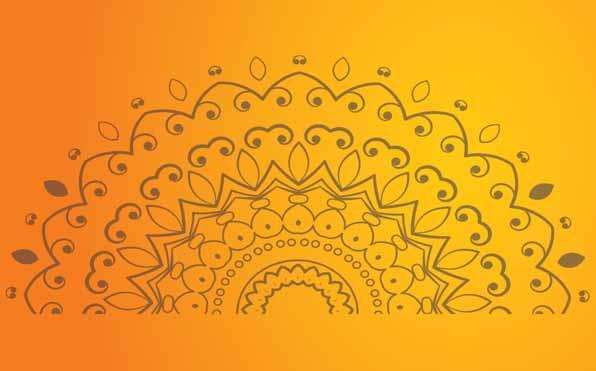












































12 RC Mysore West’s pioneering work for children with hearing loss
The club is supporting an institute that takes care of early intervention and training of hearing deficient children.
20 RC Bangalore Orchards takes up 125 Happy Schools
Children in Kolar love to attend school now, thanks to this club’s efforts.
22 Indian DGs set a goal of raising $30 million this Rotary year
A round-up of TRF Trustee Chair Gary Huang’s visit in India.
26 What’s it like to live on less than $2 a day?
An excerpt from the blog of Microsoft Co-founder Bill Gates.
34 Let’s make India literate by 2025: RIPN Shekhar
Senior Rotary leaders come together in Kolkata to take up the challenge of making India literate in 5–6 years.
39 The Great Ganga Run Rotarians of Delhi participate in the run to raise awareness for water conservation and river rejuvenation.
54 RC Omerga conserves water in drought-prone Marathwada
20
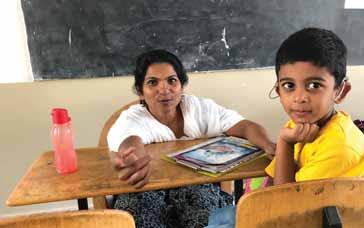

12



Farmers in the region have benefitted from this club’s project of recharging water bodies.


68 Island-hopping in the monsoon-soaked Andamans
Discover the joys of having a great holiday on a modest budget.


26

On the cover: It’s both fun and training for hearing-handicapped children at the Rotary Mysore West Institute for Mother and Deaf Child, a project nurtured by RC Mysore West, RID 3181. Picture by Rasheeda Bhagat.
22

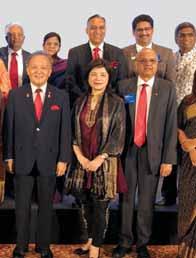

68
34




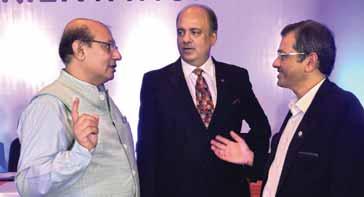


Igothrough almost all articles in the magazine and am delighted at the exemplary projects carried in the September issue. RC Solapur’s amazing tiffin-meal project has left me at a loss of words to convey my appreciation to the members and successive presidents who have kept the project alive for 12 years! I wish them all well to sustain this gigantic project for the elderly citizens — 438,000 tiffins at a cost of `1.44 crore! Bravo, friends, continue with this zeal and efficiency to do “service above self”.

RC Solapur for serving elders for the past 12 years by spending ` 1.44 crore on daily meals; this is a fine example for other clubs to emulate.
The Rotaractors of Austin Institutes deserve congratulations for their project on menstrual hygiene and making rural children aware of ‘good touch, bad touch’.
Raj Kumar Kapoor, RC Roopnagar — RID 3070
Iwasdelighted to read about the Annapurna project that feeds 100 elders on a daily basis in Solapur for the last 12 years. Run by RC Solapur, it has so far supplied 438,000 meals.
RI President Mark Maloney’s call to bring children to Rotary events will certainly lead to growth in club membership. Glad to see both RI directors have stressed the value of education. Congratulations to PRID Shekhar Mehta for being selected RIPN. RC Bangalore Orchards’ transformation of a cyanide dump at the Kolar Gold Fields to a green hill is great service. The article Sleep well… to lose weight! is very useful. Udaan, a special event by RC Nagpur for special children, is very impressive, giving joy to 800 of them. Introducing all the RI directors and trustees is a nice gesture. Thanks to the Editor and her team for sustaining the magazine’s quality.
Philip Mulappone M T RC Trivandrum Suburban — RID 3211
I’maddicted to reading Rotary News on my 30-minute train journey from Airoli, Navi Mumbai, to Nerul and back. Reading the wonderful articles is like having a delicious breakfast after the first one at home. The August issue was impressive with touching personal stories as that of PRIP K R Ravindran.
President Maloney rightly advises Rotarians to introduce their families to Rotary to kindle their interest in the organisation. RI Director Bharat Pandya has urged us to help flood-effected people, and stresses on girls’ education. Thanks for introducing RIPN Shekhar Mehta. The article Positive Health has called for a healthy lifestyle with a good diet. The article about RI Convention in Honolulu and other write-ups are also informative.
Ravinder Chot RC Phagwara South East — RID 3070
Your Editorial and the cover story on the tiffin-meal project by RC Solapur are commendable. The Rotarians in Solapur are doing a remarkable service by offering nutritious meals to the elderly for 12 years. Annapurna project is a role model for our clubs and deserves our wholehearted appreciation.
PRIP K R Ravindran shared his experience as a successful businessman thanks to timely help from his club member. A true follower of Rotary principles, Ravindran connects with people across the world.
S Mohan, RC Madurai West — RID 3000
In the Annapurna article, club president Mundana says they have never run out of money for this project. Amazing!
N Jagatheesan, RC Eluru — RID 3020
PDG Nancy Barbee’s love for India can be seen from her commitment to global grant projects during the 100 th year of Rotary in India. PDG Geeta Manek of Kenya rightly says, “education is an equaliser, brings peace and is crucial for Africa”.
The obit on PRID Sudarshan Agarwal neatly summed up the service
rendered by him through the Rotary blood bank, Delhi, Him Jyoti School, etc. Other articles on the Centenary Celebrations by RC Mysore ; and A government school gets a facelift have embellished the August issue. The views of DG Mohan Chandavarkar were interesting.
Dr Balu Uphade RC Link Town — RID 3142
ProjectPositive Health being taken up extensively in India is a good initiative; not a costly project, I wish it all success.
J P Verma
RC Bangalore South — RID 3190
To involve our families into Rotary projects, our club has started an Anns Committee which carries out many projects on their own and also attend family meetings. This initiative is fully exploring their talent to do good in the community.
C Surendran, RC Madurai North — RID 3000
Calling himself a ‘professional beggar’, the late PRID Sudarshan Agarwal was extremely generous in giving and a genial host. We have lost a great soul as the obit written by Editor Rasheeda shows. His service will be remembered by Rotarians forever. May his soul rest in peace.
The two RI Directors have rightly stressed on increasing women members in Rotary. The medical mission to Madagascar led by PRIP Rajendra Saboo has done great service. It was good to hear PRIP Ravindran say,“I am what I am only because of Rotary.”
It is an irony that despite being young, successful and empowered by the internet, the millennials are depressed. In the centenary year of Rotary in India, we wish the first club — RC Calcutta, RID 3291 — all the very best for this milestone.
S Muniandi RC Dindigul Fort — RID 3000
It is an irony that after doing good to humanity for decades many of us
are pushed to oblivion and hence, it is up to journalists to unearth such people and bring them to limelight. Had there been no obit on PRID Agarwal, perhaps his work and service, including the Him Jyoti School, would have been buried in obscurity. Thanks for keeping his work and contributions alive.
Arun Kumar Dash RC Baripada — RID3262
An exemplary bone bank
Thebone bank and Rotary’s saving infants with genetic defects make our eyes wet. We are proud of being in an organisation which really means Service above Self. A few clubs in our district have started a campaign ‘No alcohol meetings’.
Dr N R U K Kartha, RC Trivandrum Suburban — RID 3211
Happyto know about the new bone bank which was inaugurated by RC Madras Central, RID 3232.The allograft bone fitment is a wonderful gift to the cancer patients as it is less expensive and provides a permanent solution. This will spread awareness on the good work done by Rotary.
Chinmaya Mahapatra RC Bhubaneswar Heritage — RID 3262
Ifelt happy reading RC Mysore celebrates platinum jubilee . PRIP Kalyan Banerjee inaugurated the event and spoke at length about the club, underpinning the need to take up more health and education projects. The photos accompanying the write-up are superb. Also, the photo feature with the headline Enjoying a story under a tree (front inner
wrapper) gives a peek into a school run by Rotary Mysore West. Many thanks to the Editor.
H Krishna Murty, RC Mysore Brindavan Club — RID 3181
RI President Mark Maloney reminded us to grow in numbers. Rotary recently adopted a diversity, equity and inclusion policy that sends a strong message that we embrace inclusiveness. Rotary has clubs all over the world and reaches a broad range of people with service projects. So, we are already having diversity, but the other ingredient — inclusion — is the key to unlocking and maintaining the full benefits of that diversity. Kattey Halliday, author and past president of RC Adelaide, who is a facilitator in the Diversity Inclusion Branch of the South Australia Police, says, “For cultivating inclusion, we have to make our clubs accessible, give all members something meaningful to do, provide diversity and include training.” This is self-explanatory.
K M K Murthy RC Secunderabad — RID 3150
Asregular readers we can say Rotary News has evolved over the years with great diversity in articles, news coverage, and messages from Rotary leaders. The quality of reporting is great. The Editorial team is able to maintain the same quality in the Tamil edition also.
The August issue has interesting content; most appealing being PRID Agarwal’s obit. PRIP Saboo has rightly said, “the legend lives on”.
R Srinivasan
RC Madurai Midtown — RID 3000
We welcome your feedback. Write to the Editor: rotarynews@rosaonline.org; rushbhagat@gmail.com Click on Rotary News Plus in our website www.rotarynewsonline.org to read about more Rotary projects.

Dear fellow Rotarians and members of the family of Rotary,
Rotary’s long-term, sustained battle against polio has defined our organisation for decades. We have a right to be proud of all that we have accomplished through the years.
Our progress is real and noteworthy. In 1988, polio was endemic in 125 countries, with more than 350,000 new cases a year worldwide. Since then, Rotary and our Global Polio Eradication Initiative partners have reduced the incidence of polio by more than 99.9 per cent, vaccinated more than 2.5 billion children against the virus, and prevented 18 million cases of paralysis. Over the years, Rotary has helped country after country move into the polio-free column. This includes India, which some considered impossible not long ago. Of the three types of poliovirus, type 2 has been eradicated and type 3 could soon be certified as eradicated. Nigeria has not reported a case of wild poliovirus in nearly three years. If this trend holds, we will be down to just one type of wild poliovirus in only one section of the world, Afghanistan and Pakistan.
There are major challenges in that region. But it is crucial that we remain optimistic. Look at all that we have accomplished so far. This is no time to get discouraged or to think that the task is impossible. We will end polio forever, but only if we remain steadfast and vigilant. World Polio Day is a time for Rotarians from all over the globe to come together, recognise the progress we have made in our fight against polio, and plan the action we must take to end polio forever. The

key word is action, because we still have important work to do.
This year, we want to see as many Rotary clubs as possible holding World Polio Day events around the world. Need some ideas? How about organising a viewing party for friends and club members to watch Rotary’s Online Global Update? You could also dedicate a club meeting to World Polio Day or create a fundraising event. Remember, every dollar raised is matched 2-to-1 by the Bill and Melinda Gates Foundation.
Once you have created an event, register it at endpolio.org/register-your-event. Then promote it using the World Polio Day toolkit, available at endpolio.org / world-polio-day .
Mark your calendar to tune in to Rotary’s World Polio Day Online Global Update on Oct 24. This year we will stream our programme on Facebook in multiple time zones around the world. Visit the Rotary International Facebook page to RSVP to your region’s programme. And do not forget to follow the event on social media and share it with your network.
When we reach our goal, polio will become only the second human disease eradicated on the planet, and Rotary will receive international acclaim. But what matters most is the children who will never again have to face this terrible, disabling virus. Rotary must continue to connect the world in the effort toward polio eradication. It is up to us. Let us finish the job.
Mark Daniel Maloney President, Rotary International

Afterthe Godhra tragedy and the riots that followed in Gujarat in 2002, I went to Ahmedabad as a journalist to report on the ground situation. Seventeen years have gone by, but I vividly remember, as though it had been told to me yesterday, the reply I got to my question on the future of Muslims in Gujarat after these events. The question was posed to a Muslim corporator from the city. He paused for some 30 seconds and said: “Jo soch saktey hei, unka kuch bhi nahi. Jo nahi soch saktey, unka toh waise bhi nahi (There is no future for those Muslims here who can think. Those who can’t, anyway, never had a future).”
The full impact of that statement has haunted me for years, and its wisdom can be applied to any uneducated or non-thinking person anywhere in the world. Thinking, wisdom and knowledge come from extensive reading, and that too with quality education. But though we, the privileged classes, might aspire for the best quality of education that we can get for our children, there are millions of Indians for whom any education, even literacy, remains a dream beyond their reach.
This fact, and the Ahmedabad corporator’s words, were reinforced for me when I first read Bill Gates’ account of what it is like to live at less than two dollars a day, which we have featured in this issue. Of the six such persons Gates has interacted with and quoted, three have stated their strong desire to save money for their children’s education, and of these, I am not surprised, two are from India!
One of them is Lal Mohammed, who has been working as a rickshaw puller in Kolkata for 15 years. “He supports his wife and three children with his small income (less than $2 a day). But he and his wife have
big dreams for their children, hoping that they will grow up and get an education and a higher paying job than he has,” says Gates.
Devli Bai is a day labourer in Rajasthan, who works at construction sites. Divorced from her husband, she takes care of her daughter (10) and son (6). Her dream is to invest in her children’s education! Same is the aspiration of Awoke Mose, a smallholder farmer in Ethiopia. He has five children; his dream… you guessed it right… is to save “whatever money he can for his children’s education. His oldest daughter recently graduated from college.
When education is such a huge aspiration among the poor masses in India — in so many small Indian towns and villages I have seen people cutting down on their food to send their children to private schools — it should be a heavy burden on our collective conscience that India’s literacy rate is stuck at a dismal 74 per cent. That is why, when at any Rotary conference I hear a senior leader express his dream of making India totally literate, by 2020 a few years ago, and now 2025, it gives me goosebumps. Just imagine the headline: “Rotary helps bring total literacy to India”. Wouldn’t that be an even greater achievement than making India Polio-free?
While one gives physical dignity and the power of mobility, the other sets your mind free and fills it with all kinds of achievable dreams and goals and gives you the most important weapon — the power of choice. Education empowers you and gives you the ability to take control of your life, your destiny. An educated woman can defy prejudices and roadblocks and stand up and say: My life, my rules, my choice.
Rasheeda Bhagat
RI Dist 2981 DG N Manimaran
RI Dist 2982 DG Natesan A K
RI Dist 3000 DG Dr A Zameer Pasha
RI Dist 3011 DG Suresh Bhasin
RI Dist 3012 DG Deepak Gupta
RI Dist 3020 DG M Veerabhadra Reddy
RI Dist 3030 DG Rajendra Madhukar Bhamre
RI Dist 3040 DG Dhiran Datta
RI Dist 3053 DG Harish Kumar Gaur
RI Dist 3054 DG Bina Ashish Desai
RI Dist 3060 DG Anish Shah
RI Dist 3070 DG Sunil Nagpal
RI Dist 3080 DG Jitendra Dhingra
RI Dist 3090 DG Rajeev Garg
RI Dist 3100 DG Hari Gupta
RI Dist 3110 DG Kishor Katru
RI Dist 3120 DG Sanjay Agrawal
RI Dist 3131 DG Ravee Dhotre
RI Dist 3132 DG Suhas Laxmanrao Vaidya
RI Dist 3141 DG Harjit Singh Talwar
RI Dist 3142 DG Dr Mohan Chandavarkar
RI Dist 3150 DG Pandi Sivannarayana Rao
RI Dist 3160 DG Nayan S Patil
RI Dist 3170 DG Dr Girish R Masurkar
RI Dist 3181 DG Joseph Mathew
RI Dist 3182 DG Ramesh B N
RI Dist 3190 DG Dr Sameer Hariani
RI Dist 3201 DG R Madhav Chandran
RI Dist 3202 DG A Karthikeyan
RI Dist 3211 DG Shirish Kesavan
RI Dist 3212 DG S Sheik Saleem
RI Dist 3231 DG Sridar Balaraman
RI Dist 3232 DG G Chandramohan
RI Dist 3240 DG Dr Debasish Das
RI Dist 3250 DG Gopal Khemka
RI Dist 3261 DG Ranjeet S Saini
RI Dist 3262 DG Debasish Mishra
RI Dist 3291 DG Ajay Agarwal
Printed by P T Prabhakar at Rasi Graphics Pvt Ltd, 40, Peters Road, Royapettah, Chennai - 600 014, India, and published by P T Prabhakar on behalf of Rotary News Trust from Dugar Towers, 3rd Flr, 34, Marshalls Road, Egmore, Chennai 600 008. Editor: Rasheeda Bhagat.
The views expressed by contributors are not necessarily those of the Editor or Trustees of Rotary News Trust (RNT) or Rotary International (RI). No liability can be accepted for any loss arising from editorial or advertisement content. Contributions –original content – are welcome but the Editor reserves the right to edit for clarity or length. Content can be reproduced,butwithpermissionfromRNT.

TodayOne-to-One
Rotary commands respect all over the world from Governments and international organisations like the UN, WHO, UNICEF and others. Why is it so? This is because Rotarians have time and again demonstrated their willingness, commitment and ability to carry out projects — big and small, low-key and high profile, inexpensive and high-cost ones — through volunteering, across the world.
True, lasting peace can only come about when we address hunger, health, literacy issues, social ostracising, lack of water and sanitation issues in our communities. Visiting the projects of our clubs and districts has brought home to me that Rotary clubs of our zones are doing just that; focusing on economic and community development by meeting the community’s needs, and encouraging people to be self-reliant. As in women’s self-help groups Rotary is making a real difference in the community and empowering the underprivileged to truly come out of the rut and march ahead towards progress. Kudos to all clubs and districts for this significant work. Remember, we can’t change the world at one stroke, but we can make it a brighter place by our acts of service. Polio. For most of the 20th century, few single words could evoke more fear. The crippling disease strikes without warning, usually choosing children as victims, robbing for ever the simple gift of walking or playing. Polio does not discriminate. As we focus on World Polio Day on Oct 24, we must remember that the End Polio Now campaign is not just about raising money, but protecting children. As we approach the finish line, we realise that the last mile seems most challenging and so we must continue our hard work and commitment to ensure a polio-free world.
To tweak former US President John F Kennedy’s famous words: “The time has come to ask not what my Rotary club can do for me, but what I can do for my club!” The answer is simple. We can help our club to grow, thrive and flourish by active participation, commitment and involvement in our Rotary clubs. And to celebrate October — Economic and Community Development month — by focusing on those — small and big — acts of Kindness and Love, things we can do right now. Keep Doing Good in the World.
Enjoy Rotary, Enjoy Yourself.

Dr Bharat Pandya RI Director, 2019–21
Dear Rotary leaders,

Our entire community must be bold in its mission of authentic caring for one another in order to influence a better tomorrow. — Michelle Homme
Nearly1.4 billion employed people live on less than $1.25 a day. I urge each Rotarian to promote economic and community development and reduce poverty in underserved communities through training, well-paying jobs, and access to financial management institutions. Projects can range from providing people with equipment to vocational training. We must work to strengthen local entrepreneurs and community leaders, particularly women, in impoverished communities.
Globally nearly 74 million young adults are unemployed. Youth are our only sustainable asset. We must create skill, leadership and job opportunities for them and lift them out of poverty to foster sustainable economic growth.
Adopt a village
I request each club to adopt a village and improve basic education, water, sanitation, health and other facilities there. This will empower the village to become self-sufficient and promote its total well-being.
Women’s empowerment
The old adage holds good: “If you educate a man, he gets educated for himself, if you educate a woman,
the entire family gets educated and empowered.” Empowering women and girls is the key to social transformation. Let me commend RID 3250 for running ‘Saheli’ centres — the 28 vocational training centres empowering thousands of women over several years.
Lord Loomba Foundation, UK, has partnered with Rotary to provide skill and vocational training to widows and their children across India. Five districts have started the centres and five more will be establishing their centres shortly.
There is no greater joy than to finish the race. We have pledged to eradicate the world of Polio and I request each Rotarian to rededicate himself/herself to see this battle through.
October 24 is World Polio Day. We need your voice to help end Polio. Get involved and spread the message through fundraisers, events, rallies and awareness programmes, so that yet another human disease can be eradicated from the world after smallpox.
Let’s End Polio and make history.

Board of Permanent Trustees & Executive Committee
PRIP Rajendra K Saboo RI Dist 3080
PRIP Kalyan Banerjee RI Dist 3060
PRID Panduranga Setty RI Dist 3190
PRID Sushil Gupta RI Dist 3011
PRID Ashok Mahajan RI Dist 3141
PRID Yash Pal Das RI Dist 3080
PRID Shekhar Mehta RI Dist 3291
PRID P T Prabhakar RI Dist 3232
PRID Dr Manoj D Desai RI Dist 3060
PRID C Basker RI Dist 3000
TRF Trustee Gulam A Vahanvaty RI Dist 3141
RID Dr Bharat Pandya RI Dist 3141
RID Kamal Sanghvi RI Dist 3250
Executive Committee Members (2019–20)
DG Deepak Gupta RI Dist 3012
Chair – Governors Council
DG Nayan Patil RI Dist 3160
Secretary – Governors Council
DG Dhiran Datta RI Dist 3040
Secretary – Executive Committee
DG Ajay Agarwal RI Dist 3291
Treasurer – Executive Committee
DG Rajendra Madhukar Bhamre RI Dist 3030
Member – Advisory Committee
Kamal Sanghvi RI Director, 2019–21 ROTARY NEWS / ROTARY SAMACHAR Editor Rasheeda Bhagat Senior Assistant Editor Jaishree Padmanabhan
ROTARY NEWS TRUST 3rd Floor, Dugar Towers, 34 Marshalls Road, Egmore Chennai 600 008, India. Phone : 044 42145666
e-mail: rotarynews@rosaonline.org Website :www.rotarynewsonline.org
Now share articles from rotarynewsonline.org on WhatsApp.
WILL
GLOBAL REWARDS TAKE YOU?
NiveshGuru, a one-stop solution for all your investment needs.
Rasheeda Bhagat
Blindness separates people from things; deafness separates people from people.
- Helen Keller
Now that you’ve been at this institution for 30 years, how many hearing-handicapped children have been integrated into regular schools, I ask Parimala Murthy, who heads the Rotary Mysore West Institute for Mother and Deaf Child in Mysuru.
“Oh, that number is in thousands,” is her confident and enthusiastic reply.
Accompanied by RI District 3181 Governor Joseph Mathew and Reginald Wesley, President of RC Mysore West, which has been nurturing this project for long years, I visit the spacious campus of the institute, which both the Rotarians proudly point out, is probably the only one-of-its-kind in entire Asia. The facility is for early intervention
and special training of hearing deficient children so that they can be integrated into regular schools. The classroom is both cheerful and colourful, and buzzing with energy, enthusiasm and vibrations that only places for children can generate.
We walk into the Kannada section — the institution offers facilities for mothers and children in Kannada, Hindi, Telugu, Malayalam and English — and find the place filled with bright colours and incessant chatter and laughter of children. In this unique model and training institution for deaf children, the teachers and counsellors are mothers of hearing-handicapped children. “We do not hire teachers; here the mothers themselves are the teachers; they stay with the children at the residential facility we provide

Mothers teaching children at the Institute.

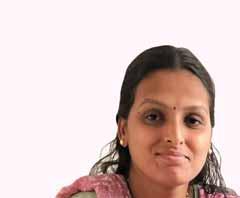
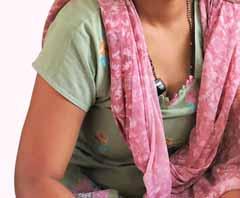

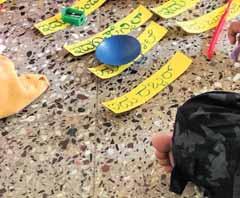
and are constantly training them how to speak,” explains Wesley.

Early intervention crucial When it comes to a hearinghandicapped child, the common mistake most people make is to club “deaf and dumb”, as though both the handicaps go hand-in-hand. They don’t. A deaf child often remains
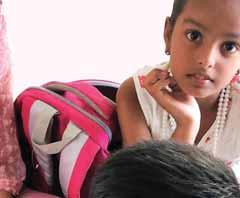



mute because she can’t hear sounds and transmit those sounds into speech, which is how every child learns to speak. Over long years, parents who have realised this and got early intervention for their children through the best of hearing aids, and cochlear implants, have succeeded in getting their children to speak, attend regular schools and colleges, and compete on an equal footing with other children. Many of the children trained at this institute, get into good colleges and get gainful employment, many of them at prominent companies in the US and India.
But it all boils down to early detection of the impairment and immediate action to ensure that the child gets adequate training for integration into a general school. But sadly, there is a huge dearth of knowledge and lack of training facilities to train such special children at the earliest and bring them into mainstream education.
Ruing the lack of awareness levels in India among parents to address hearing deficiency in their children, DG Mathew says, “Add to this the inadequate number of training centres to handle such children so that they can quickly be integrated into normal schools, the potential of these children remains untapped, and they lose opportunities for gainful employment.”
The genesis
Let’s wind back the clock by some 40 years and look into the life of Raja, the son of Wing Commander K K Srinivasan,

Mother plays a very important role in training the hearing and speech of a child because the child has learnt to recognise her voice right from the womb.
Parimala Murthy Head, Rotary Mysore West Institute for Mother and Deaf Child
who had a hearing disability from birth. To help his son Raja, Srinivasan resigned from the Indian Air Force and began the process of educating Raja in the Woodford Aural Method at Bala Vidyalaya, a school for the hearing- impaired in Chennai.
Srinivasan and his wife gave total attention to the training of their son and subsequently moved to Mysuru, where they set up a preschool for the benefit of other hearing-impaired
children, on the first floor of their own house. This was in 1980, the International Year of the Handicapped. Initially the school had five deaf children, and all of them came with their mothers.
Says Parimala: “Mother plays a very important role in training the hearing and speech of a child because the child has learnt to recognise her voice right from the womb.”
At this preschool run by the Parents Association of Deaf Children, as the numbers increased, the association appealed to the local urban development authority for land and got allotted an acre of land at Bogadi, Mysuru. Funds were then raised to build a school which was named Institute of Mother and Deaf Child.
A partnership begins Wesley adds that various philanthropic individuals and organisations such as Jindal, Jain Samaj, State Bank of India and Rotary contributed
for the construction of the school and hostel buildings, equipment and setting up a library. In 1995, Rotary Club of Mysore West got inspired by the good work done by this institute and joined hands with the Parents Association of Deaf Children and thus was born a great partnership and the Rotary Mysore West Institute for Mother and Deaf Child came into being.
This is a residential facility which encourages children to be brought here at a younger age — ideally below three years — and “the mothers have to compulsorily attend the school with their children daily. We believe that the mother is the main teacher, as the child is more attached both physically and emotionally to her. She plays a very crucial role in the overall development of the hearing-impaired child,” he adds.
All the children here are fitted with cochlear implants; “this is very

Namrata interacting with a child.


expensive running into lakhs of rupees, but now various government schemes are available and we give parents the details and tell them how to benefit from these schemes,” says Parimala.
Is there discrimination in the gender of the child who is brought here for special training, with sons being preferred over daughters? She smiles and says, “No, we don’t see any such discrimination; in fact, we have more girls here!”
Usually the child is trained in his/ her mother tongue first; and at the outset the mothers are trained how to make their children listen, lip-read, with the training material using a lot of colourful images to stimulate the

child’s learning. As the child makes progress, his/her reasoning and analytical abilities are improved through activity-based lessons.
The mother herself is trained by a group of counsellors whose children benefitted from this facility and who have volunteered their services. The ultimate objective is smooth integration of the child from this institution to a general school. The process takes from three to four years. But the results are great. Most of the children, after undergoing training here for three or four years go to regular schools, with many graduating from colleges and getting good jobs.
The first student
Technically, Srinivasan’s son Raja was the first student here and he has

done PhD in both law and computer science in the US. He is a perennial source of inspiration for other children. The story of how Parimala herself landed up in this institute as a mentor is interesting. Having dealt with a hearing-handicapped cousin herself and constantly experiencing his frustration, she was both intrigued and fascinated when she saw Bharat, a hearing-impaired child, studying with her own son in Class 1, in a mainstream Mysuru school.
“We had so much trouble in interacting with our cousin; often he would get angry and we were not able to understand his anger and his difficulties. So when I saw Bharat in a normal school with my son, I got both excited and interested to know how this was possible.” She became friends with his
mother Rathna Shetty, who is a trustee at this institute and started working here as a volunteer, and is now a fulltime mentor at this institute.
As we watch the women interacting with the children — mothers and the children are often swapped for varied learning — she explains, “All the women/teachers you see here are parents.”
So are they special educators? “No, no, here we don’t see any degrees or training. As counsellors, we have only mothers who have trained their own children and integrated them in regular schools.”
Star students Bharat, she adds, went on to do his MS in Florida and joined IBM through a campus interview. “Once we integrate these children into normal schools, they become like other students. They go for higher education, get good jobs, get married and have their own families. They are independent and most of them keep in touch with us and sometimes even donate money. Just before you came, two boys were here; one of them has got 93 per cent in Plus Two and is joining a good college.”
She says another student from Andhra Pradesh had called her recently to say that he had got a very good rank in JEE and was joining an IIT. Another three students recently
joined tech major Wipro, after completing M Tech.
DG Joseph explains that as the children grow older their speech improves. “Once they go to mainstream schools and mix with their peers, when they find their speech is not understood fully, they strive to improve it so they can be understood easily.”
We walk into the Kannada section at the institute to find each parent
educating a child, not necessarily hers. As I try to talk to the children, take their pictures, and interview their mothers, little Rudran is rearing to grab my tape recorder. In fact, all the kids are most intrigued about the recorder; the mobile phone and camera they seem to be familiar with. Rudran wants to know whether I am taking pictures or a video on my mobile phone, and then wants to check out the pictures. He has to be “disciplined” by Namrata, who is teaching him. But her gentle chiding
My daughter stayed in Chennai alone as a paying guest. When trained properly, these youngsters can be really independent.
Jalaja, a trustee

has little effect and he is all over the place, playing pranks on other children. The place is as lively and as noisy as you’d see any facility full of kids.
Parimala introduces me to Vijaya, a counsellor — this centre has 14 counsellors — whose daughter Kavita went through speech training here, went on to a regular school and then qualified as a chartered accountant and is now working in Wipro. “She got a girl baby last year,” says the mother proudly.
Mathew explains that of the 12 trustees here, six are from Rotary and the other six are parents. Jalaja, a trustee, is a veteran mother; her daughter Tanuja went through training here and is now married. “She is 29 now; we found out that she had a hearing deficiency when she was less than two, but at that time we did not know about this centre. So I brought her here only when she was five. Both of us stayed here for four years and my daughter benefitted from the training and went on to a regular school.
She got a BCA degree, and was first working in Bengaluru and then Chennai in the IT industry, but resigned after marriage,” says Jalaja, adding proudly, “she stayed in Chennai alone as a paying guest and managed on her own. When trained properly, these youngsters can be really independent,” she says.
Parimala adds that when a mother first comes in with a child, she is trained by another mother or counsellor for at least three months before a child is entrusted to her.

What the Rotarians and the parent organisation have managed to create together is commendable. The premises are spanking clean, and exude warmth and cheer with brightly painted and well-ventilated classrooms filled with colourful toys, charts and other fun learning material. The chairs for the children are specially made and are raised so that they can see the mother/teacher’s face. There is a hostel, which was the Rotary millennium year project for

Most of this place was empty ground when Rotary joined this venture; we’ve constructed most of the buildings.
DG Joseph Mathew
RC Mysore West, which accommodates 26 mothers and their children coming from a distance. Others have to organise rented accommodation near the place. In all there are 120 mothers with their children at this centre.
There is an audiology room for diagnosing and fitting hearing aids/ cochlear implants. I am taken to a sound proof room which had been built to provide auditory verbal therapy, and the training imparted here to the children is of high quality indeed. The sound proof room is very important because once the child gets a cochlear implant, special training helps not only optimise maximum hearing, but also to experience varied sounds.
Wesley adds that the fee charged for the hostel accommodation and the training is nominal.
Over the years the funds required for the construction of classrooms, buildings, buying equipment and for recurring expenses have been raised from donors, philanthropists and Rotarians. “We have sustained this project over long years and so many matching grants have gone into this. Most of this place was empty ground when Rotary joined this venture; we’ve constructed most of the buildings,” smiles DG Mathew,
adding “this particular wing where we are standing was inaugurated by PRIP Kalyan Banerjee in 1996.”
Namrata has been around here for seven months with her daughter Mitra, who is 4. “We found out about her hearing deficiency when she was over two years old, got her fitted with cochlear implants and she is now able to communicate,” says Namrata. She has two daughters, the elder one is now in Class 6 and has normal hearing.
Molina is here with her daughter Saloni; “we found out about her handicap a little after she turned one; we are from Udupi.”
The mother and child stay in the hostel and her husband, who works in Udupi takes care of the older daughter. Responding to my question, Molina says, “Yes, it is difficult to leave home and stay here, but I am doing it for Saloni’s future. If she is trained properly, she will be able to go to a regular school.”
Similarly, Revathi, who is from Hosur, has also left behind the rest of her family to be here. “Unfortunately, we don’t have such a training institute in Tamil Nadu,” she says.
Meanwhile, in the classroom, Namrata is asking Rudran: Where does amma prepare chapatties?
In the kitchen.
What is the shape of the chapatties?
A circle.
Rudran answers her questions, though not at one go! He has enough distractions around him, including the visitors.
But day-after-day, he, along with the other children, is discovering the world of speech, which is slowly, but surely, unfolding before him.
Pictures by Rasheeda Bhagat Designed by Krishnapratheesh S
V Muthukumaran
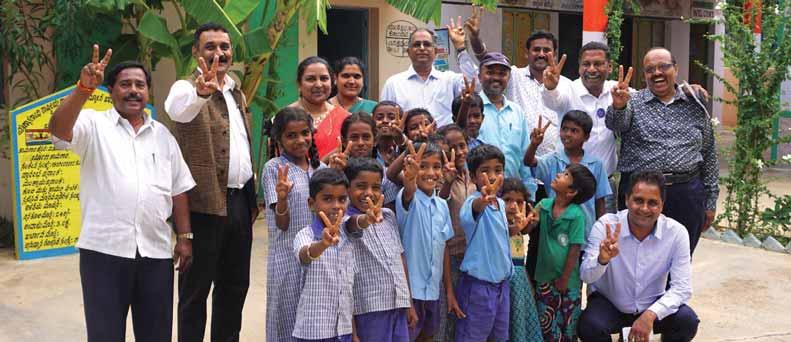
Children in bright uniforms welcome us with a broad smile and the school teachers led by the headmaster greet us with gratitude as we step into the Government Higher Primary School (GHPS) at Yaluvahalli village in Bangarapet taluk, Kolar town, 90 km east of Bengaluru.
From a state of dire neglect to a freshly-painted, new gleaming look with colourful play equipment, beautiful sketches of flora and fauna on the walls, and inspirational messages, proverbs on slates in the classes, “now we have a school that is the pride of the village. We owe it to Rotary for giving us a new confidence,” said
M Amarnath, headmaster, GHPS. This school is one of the beneficiaries of the 125 Happy Schools and Anganwadi Project of RC Bangalore Orchards, RID 3190.
“We have planted crotons and select trees on the campus, refurbished the classrooms and renovated the toilets with steel doors and new tiles,” said Prakash Hegde, Project Co-chair and past president of the club. Each of the five taluks, chosen for the project in Kolar district, had around 20–30 schools for Rotary makeover and anganwadis (child care centre under the ICDS programme) were also given a facelift.
The GHPS had 42 students with 22 girls studying up to Class 7.
A handwash station was installed to ensure better hygiene among students and a water filter unit with a 100-litre storage container keeps providing fresh, clean water to the students.
Karnataka government’s Nali Kali (play while learning) is being showcased here with five colourful, short round tables that enable children (up to Class 3) to sketch, draw and create paper craft, thus giving wings to their imagination, said Hegde. In the last 25 years, this school had never seen such a massive revamp of its infrastructure as “more than 90 per cent of the government spend for primary education goes towards salaries and we have changed all that with a complete
makeover,” said D Ravishankar, past president, RC Bangalore Orchards.
A Kannada medium and Urdu schools are located on the campus of GHPS at Ithandahalli village with teachers and students hailing from the two communities. Here too the entire plumbing lines and toilets were revamped, giving a beautiful ambience to the classes which have new teaching kits for interactive sessions. While the Kannada school has 36 students enrolled up to Class 7, the Urdu school has 12 children till Class 5. “The Ganapathy shrine in the middle of the campus links the two schools, thus telling us symbolically to live in harmony,” said B Chandraiah, the headmaster.
M L Nagalakshmi and S Farzana, two teachers, said Rotary has brought facilities that encouraged them to take

up classroom activities in a fun-filled and interesting manner.
At the anganwadi located at the GHPS, Mallasandra, the children were delighted that their creche had got a new makeover. “We have relaid
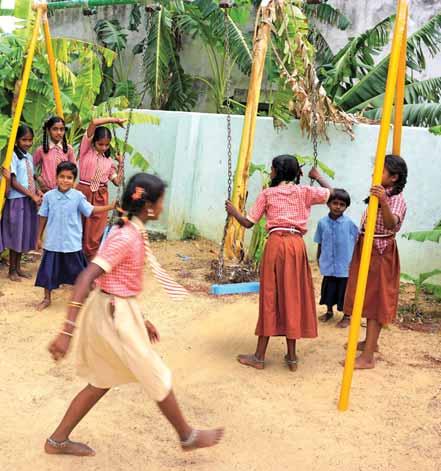
using
the tiles, given a facelift to the hall, renovated the toilets as well as the kitchen,” said Hegde.
By June-end, the club had completed the pending work in the remaining 10 schools in Kolar district. “On an average, each school costs ` 4.5 lakh excluding major capital work. Hence, the overall project cost works out to `5.62 crore,” said Ramesh Chari, a club member. About ` 70,000 were spent on each anganwadi, and the club has taken up 80 anganwadis in Kolar district for a makeover.
The 125 Happy Schools project had a seed funding of `1 crore from the Paola Dakoju Ravishankar Foundation and the balance was mobilised through donations from Rotarians either in cash or kind. Moreover, Ravishankar is also funding the construction of a government primary and secondary school which will have Kannada and Tamil mediums at Vasanth Nagar in Bengaluru at a cost of `5.5 crore. “We are happy to inform you that the club has exceeded the target by completing 126 Happy Schools and 40 anganwadis, besides revamping 115 Nali Kali schools in the Kolar district,” signs off PDG Suresh Hari.
Pictures by V Muthukumaran
Today I saw Rotarians who are really and truly people of action; I was very impressed with this project that Rotarians in RI District 3150 are running in such a central place in Hyderabad, offering quality dialysis service at such a modest cost,” Trustee Chair Gary Huang said after visiting a global grant project done by Rotary Club of Hyderabad Deccan.
He said the project, that is jointly being implemented by the Se cunderabad Gurudwara, the Bhagwan Mahavir Trust and the Rotary club, was a fine example of partnership and collaboration.
Sunil Jain, under whose presidentship in 2015–16 this global grant
was done, said the 12-bed facility had become a reality through a $60,000 global grant done in partnership with an American club in RI District 6450. This centre offers a dialysis session for as low as `300, and is a boon to middle class people with kidney disease.
Added Gary, “I was both surprised and amazed at the low cost at which such a quality medical service is being offered to people in such a clean place. To run a medical centre at such a costly location would have pushed up the price, but this organisation (gurudwara) has offered the place free of cost. I was most happy to see the patients undergoing dialysis smiling and so happy. I am told that such a dialysis session would cost 8 or 10
times more in a private facility offering similar quality care. I would call it a very smart and intelligent project.”
Accompanied by Trustee Gulam Vahanvaty, EMGA Sam Patibandla, RID 3150 DG Sivannarayana Rao, Club President Shailesh Gumidelli and other members of the club, the Trustee Chair walked around the dialysis facility, shaking hands with the patients and talking to them.
Praveen Kumar, 53, is an electrician and ended up with a kidney problem four years ago due to an enlarged heart. “I come here thrice a week, and have been doing so for the last four years. I have to pay only `300 for a dialysis session and I don’t have to travel far for it,” says the grateful man.
TRF Trustee Chair Gary Huang, Corinna and TRF Trustee Gulam Vahanvaty with AKS members Ramesh Agrawal, Maullin Patel, Sonal, Dayanand Gauri, Meera, Dr Krishnendu Gupta, Sudhi Jabbar, Vikram and Vyjayanti Reddy, Ravi Vadlamani, Uday Pilani, Marri Ravindra Reddy and Roopal Pilani.

Similarly, P V Ram Reddy, 63, a retired lecturer, who needs a dialysis sessions twice a week and has been coming here for six months, says he cannot afford to pay `2,000–2,500 that private hospitals charge for one dialysis session. “I am grateful to these three organsiations for making dialysis affordable for me.”
Lavina John, a beautician, says both her kidneys are shrinking and hence she needs dialysis at regular intervals, and so does Firdause, whose husband works in catering.
Sharath Choudary, another member of the club, adds, “Next year we will be adding six more machines as the gurudwara is making some more space available.” While the dialysis machines have been put up by Rotary, the Mahavir Foundation runs the place with its technicians and other supporting staff, this being one of the four centres it runs in Hyderabad. Vahanvaty adds: “This is such a perfect project; it’s communitybased and it is wonderful to see three entities — Rotary, the gurudwara and the Mahavir Foundation — coming together to provide this excellent service.”
Past president Jain adds that this project has been running smoothly for the last four years; “we do about 750 to 800 dialysis sessions a month, which adds up to 10,000 a year. The Mahavir Foundation was a great partner because as they already ran other centres, they have the technical knowhow to run the operations.”
In the evening, RC Hyderabad Deccan hosted a CSR conclave in which several corporate heads were invited for an understanding of how they can partner with The Rotary Foundation to most effectively use their CSR funds mandated by the Government of India.

At a joint programme for RI Districts 3150 and 3020, the AKS members from several districts were honoured.
Addressing the meet, EMGA Sam Patibandla thanked Vahanvaty for choosing Hyderabad as one of the five cities for the Trustee Chair’s visit. “Our zones are doing very well, in both participation in community welfare projects and also TRF contribution. During the last Rotary year, 2018–19, the contribution from our zones was an all-time high at $21.4 million.” While District 3190 emerged at the top with $3 million; RID 3141 came second with $2.6 million. If RID 3141’s TRF contribution was to be clubbed with that of 3142 (both together earlier formed the combined district 3140), it would emerge at the No 1 position at $3.8 million.
He announced that this year, the district governors from our zones (including Sri Lanka and Nepal) have put their TRF goal at $30 million.
Another feather in India’s cap, added Patibandla, was that its elite AKS club had reached the mark of 100, and “we’ve just overtaken Taiwan. We are lucky to have today with us nine AKS members from Rajasthan and Gujarat (PDGs Ramesh Agrawal; Maullin and Sonal
Patel from RID 3054); West Bengal (Krishnendu Gupta D 3291); Andhra Pradesh and Telangana (Dayanand and Meera Gauri; Vikram Reddy and Vyjayanthi; Uday and Rupali Pilani; Ravi Vadlamani and Marri Ravindra Reddy from D 3150), a nd Kerala (Sudhi Jabbar, D 3211).
Patibandla disclosed that Uday Pilani and Rupali were the “Rotarians who had successfully bid for the “End Polio” paintings that were done on the stage by a young painter from the Bahamas at the Hamburg Convention. Both the paintings were displayed in the corridor at the event.
Welcoming Trustee Chair Gary, Trustee Vahanvaty, and the corporate representatives, Shailesh Gumidelli, President of RC Hyderabad Deccan which presented a cheque of $300,000 to TRF, said, “Our love affair with TRF began long ago; we were one of the first clubs to become 100 per cent PHF in RID 3150, and we have now two AKS families, 20 Major Donor families and over 50 PH Fellows and all the members contribute to the
Foundation every year.” When it came to community projects, the members worked mainly to promote education and literacy and control disease and “we do this with the support of TRF, Rotary friends around the world and of course our members.”
RID 3020 DG Veerabhadra Reddy (Bobby) said as on July 1, 2019, there were 3,231 PHFs in his district which had a membership of 3,776. “During 2018–19 our district contributed $100,000 for polio, and this Rotary year, we want to double it to $200,000. So far nine global grants have been implemented, two more are in the pipeline, and applications for another two are in the offing. RC Vijayawada Midtown, one of the biggest clubs in the world with 747 members is going to cross the membership mark of 800 very soon.”
When he added that last year his district had raised $862,000 for TRF, Patibandla said, “This year your goal is $1 million, I hope.”
RID 3150 DG Sivannarayana Rao said that at the last Disha (district officers training programme) the target
Below: Members of RC Hyderabad Deccan present their contribution to TRF Trustee Chair Gary in the presence of Corinna and TRF Trustee Vahanvaty.
given was $750,000, “but we surpassed it. By seeing the momentum, I am sure I can raise $1 million this year. We plan to convert 1,000 schools into Happy Schools, work for women’s empowerment through micro enterprises and induction of more women into Rotary.”
Another goal was to raise his district membership from the present 3,568 to 5,000, of which around 500 would be women, he added.
Sharath Choudhury, a member of the club, made a presentation on CSR contributions in the world, explaining at length how various philanthropists spent their wealth on the social sector, and “how a gold mine is waiting for us to be discovered.” Interestingly, he added, that in India, contributions from ultra HNIs was `24,000 crore, twice the amount spent from CSR funds (`12,000 crore). “And 80 per cent of the money from the ultra HNIs comes from one man — Azim Premji through his Azim Premji Foundation. We have to ponder… what is it that makes a man like Premji, or Rtn Ravishankar from (RC Bangalore Orchards) or Bill Gates or Warren Buffet give so much of their wealth.”
Quoting another philanthropist, Rockefeller, who said “philanthropy, when done with involvement, innovation and passion can transform society,” Chowdhury added that the greatest philanthropists didn’t just give their money to the PM or CM’s relief fund but used it through personal involvement.
On why he decided to become an AKS member, Uday Pilani said that a few years ago when he returned from Nigeria and learnt that Vikram Reddy had given $250,000 to TRF, “I wondered if I could do it too. Then I saw Ravishankar from Bengaluru give `100 crore, and that gave me the inspiration. I explored why people give to the Foundation. Having been a Rotarian for 15 years, I had done projects but didn’t know details of how the money came. When I dug deeper into the Foundation, I found that TRF structures well and makes much bigger the work I want to do.” And his mind was made up!
Presenting a cheque of $60,000 to TRF, PDG Ravi Vadlamani, from RID 3150, said this money would go into a cancer detection lab project which cost upward of ` 1 crore. “This is in memory of my mother who had cancer; when you give to TRF, the money not
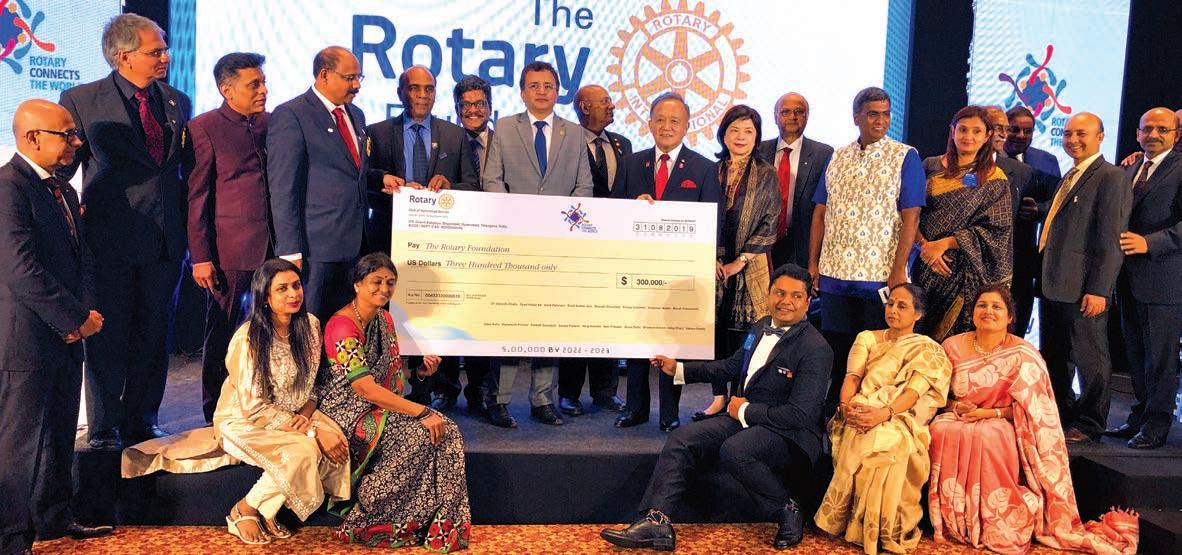
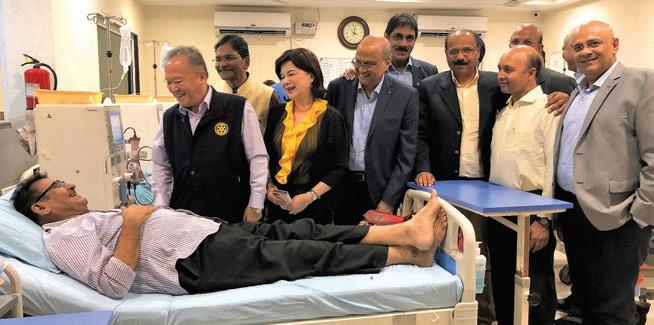
only goes to the charity of your choice, but it gets multiplied.” Addressing the corporate leaders present, he said that they could safely entrust their CSR funds to TRF because “your rupee or dollar gets multiplied severalfold, and we will do the project work for you with the strictest of stewardship principles and proper accounting.”
Thanking the Rotarians from RI Districts 3150 and 3020, Trustee Chair Gary said: “The money you give to TRF is serving humanity and making the world a better place. Your money makes a difference in every part of the world, because Rotarians have the enormous potential to change the world… to fight disease, conflict, tackle poverty and improve lives.”
Giving an example, he said that in Lebanon, where there was acute water scarcity and children who could not buy water, and hence fell sick, “your money went to work in water projects that were done by Rotarians in several schools. Now, 6,742 children have access to clean drinking water every day, thanks to you. Think of the joy those children feel every day to have access to clean water. This is your Foundation at work… making a
difference. I would encourage you to do even more.”
This year TRF had an ambitious goal in all areas… global grants, endowment fund, etc. “We want to do even more, we want to expand our reach and for that we need more major donors. But seeing your commitment and the fact that today I am in the presence of very generous people, who have discovered the joy of giving, I am confident that we can do even more selfless acts.”
Addressing the “very powerful group of Rotarians present in the room,” Trustee Gulam Vahanvaty said thanks to the leadership of DGs Siva and Bobby, both the RI districts were doing well in TRF contributions and community projects.
Turning his attention to corporate leaders in the hall, Vahanvaty narrated his experience with an IT company called Atos in Mumbai. “Last year, the DG of RID 3142 had a friend in his own club who is a senior member of Atos. They started talking about CSR funds and he said his company would give a substantial amount.”
There was some difficulty in finalising the terms of agreement and the DG asked Vahanvaty to come to the
Atos office to clarify matters. “I went thinking it would be a small office with a few employees. I was surprised to find that they had a huge office in Navi Mumbai, with 2,000 employees. They have an even bigger one in Bengaluru with 9,000.”
The company’s headquarters is in France, but because it is based in India it has CSR responsibilities. “Because this executive was a member of RC Thane Hills, he could have easily given the $250,0000 to the club but his boss said ‘No, we want to give the money to TRF.’ So TRF got that money on behalf of Atos and the club. As you can see, reputed corporates trust us on integrity and stewardship.”
Expressing a major concern to senior Rotarians, the Trustee said that during his visits to clubs and districts, “when I speak about TRF, I find lack of knowledge about the basics of TRF, even among Rotarians of five to seven years experience.” He requested all DGs to hold training sessions for Rotarians, and appealed to Sam Patibandla as an EMGA to take the lead in educating Rotarians with the help of an “excellent video presentation we have prepared.”
He was happy that for the fourth year, India held its second position in giving to TRF; $21.4 million last year, and “three of our districts — 3190, 3141 and 3011 — were among the top 10 in the world. He congratulated PDG Ramesh Vangala for his leadership in getting D 3150 to contribute $860,000. “With your money we do so much good in the world, and in India there is so much disparity and a lot of work needs to be done for the underprivileged. Yet, I am happy that we gave more than we received last year.”
“At the dialysis centre,” he added, “I saw your passion and commitment and also saw how teamwork gets the best results.”
Pictures by Rasheeda Bhagat

a day?
It’s the lack of shoes that I remember most. It was 1993. Melinda and I were travelling through Kenya, Tanzania, and Zaire (now the Democratic Republic of the Congo). During our visit, we were struck again and again by seeing people walking along the side of the road. Nearly all of them were barefoot.
This was the first time either one of us had seen extreme poverty up close. While I was aware of the vast inequalities in the world, I had never come face-to-face with people living on the bottom rungs of the income ladder — people so poor they didn’t have shoes.
Of course, they lacked much more than that:
healthcare, education, better seeds and tools to grow more food, and, above all, opportunity. Seeing this with our own eyes was life-changing. We asked ourselves why the world had to be like this and what we could do to help. Our search for answers altered the course of our lives and led us to start our foundation.
In the years since we took that trip, the world has made huge progress in the fight against poverty. More than one billion people have lifted themselves out of extreme poverty, driven by improvements in health, agriculture and education. Still, the number of people living on less than $2 a day — $1.90 is the World Bank’s international
poverty line — is over 700 million. And much more work needs to be done to keep up this progress, so everyone, no matter where they live, will have the opportunity to lead healthy, productive lives.
What’s life like on less than $2 a day? While I can quote many statistics about trends in poverty, it’s difficult for most of us — especially those living in the wealthiest countries — to answer that question. It’s hard to appreciate the uncertainties of life with so little income or imagine the day-to-day hardships.
That’s why I’d like to invite you to listen to the voices of some of the world’s poorest people answer that question for themselves. Here are six
short narratives about living on less than $2 day, as told by a Rwandan fisherman; an Ethiopian farmer; a rickshaw puller in Kolkata, India; a Kenyan grandmother; a food hawker in Nigeria; and a day labourer in Rajasthan, India.
Walk for a moment in their shoes, or in some cases, imagine life without shoes at all. I hope you will be touched by their stories, their challenges, and their dreams for better lives. I also hope that you’ll ask yourself what you can do to help the millions of people like them.
The Street Hawker Serin Dossa is a street hawker, selling corn porridge, in Lagos, Nigeria.

She supports her three children and husband with her income of less than $2 a day. She belongs to a savings group, which allows her to save what she can and take out small loans.
Ndikumana Gervais is a fisherman in Bugesera, Rwanda. He supports his wife and three children with his income of about 1,500 Rwandan francs per day (about $1.73). While his life is hard, Gervais is working to improve his family’s future. He is raising a herd of goats, farms a plot of land, and belongs to a village savings club which allows him to take out small loans.
For the last 15 years, Lal Mohammed has worked as a rickshaw puller in Kolkata, India. In rubber sandals and shorts, he ferries passengers and packages through the city streets, earning less than $2 a day. He supports his wife and three children with his small income. But he and his wife have big dreams for their children, hoping that they will grow up and get an education and a higher paying job than he has.
Awoke Mose is a smallholder farmer in Work Amba, Ethiopia who grows teff, wheat,

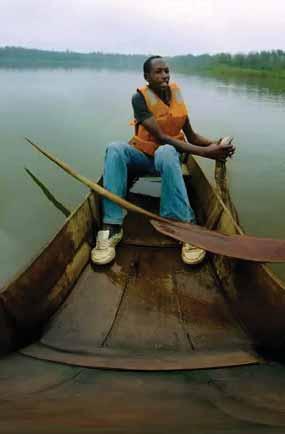

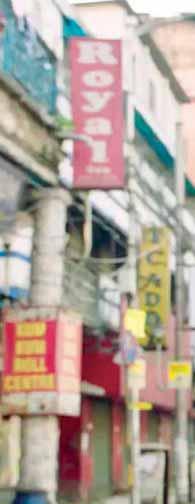



chickpeas and maize. He, his wife, five children, and his mother all live on the same one-hectare plot. He saves whatever money he can for his children’s education. His oldest daughter recently graduated from college.
Day Labourer
Devli Bai is a day labourer in Rajasthan, India, finding odd jobs including work at a construction site. Divorced from her husband, Devli takes care of her 10-yearold daughter and 6-yearold son. Her dream is to invest in her children’s education.
Petronilla Malesi is a grandmother living in Kibera, one of the poorest slums in Nairobi, Kenya. After her eldest daughter passed away, Petronilla became the sole provider for her four grandchildren. She also supports two of her daughters. She earns money by selling ice pops in the street and taking odd jobs when she can find them.
The writer is Co-chair of Bill and Melinda Gates Foundation and Microsoft Co-founder. The article first appeared in The Blog of Bill Gates: www.gatesnotes.com.
V Muthukumaran
Addressing a Multi District TRF Conclave in Chennai, Trustee Chair Gary Huang urged district governors in our zone to raise their TRF contribution by at least five per cent.
“But you have to narrate to your Rotarians our great community projects, 30-year battle against polio, providing sanitation facilities and clean
drinking water,” he said. Clubs should also make optimum use of their DDFs to make a greater impact.
Learning must never stop for self-improvement, especially for Rotarians who strive for a better world, he said. On his fourth visit to Chennai, Gary said he was always “amazed” by the enthusiasm of Rotarians and their diverse projects.

Trustee Gulam Vahanvaty said last year our zone gave $21.4 million and received $21 million as global grants from TRF, against the second-ranked Taiwan getting only $4.5 million. “Though US has given $186 million, it has received just $2 million for global grant projects. This only shows that funds are directed to regions where there is a
felt need, irrespective of their contributions to the Foundation,” he said.
DG G Chandramohan said that RID 3232 had revised its original TRF goal from $1.5 million to $2 million following a nudging by Vahanvaty. “We will be submitting at least 30 global grant projects this year.”
In membership (5,300) and TRF giving, at $1.16
RID 2982 DG A K Natesan presenting his cheque for `1.04 crore to TRF Trustee Chair Gary Huang at the multi-district conclave. Also in the pic from L: PDGs (RID 2982) Dharmesh Patel, Vasu Rajaram, DG (RID 3232) G Chandramohan, District Secretary Ganapathy Suresh, Corinna Huang and TRF Trustee Gulam Vahanvaty.
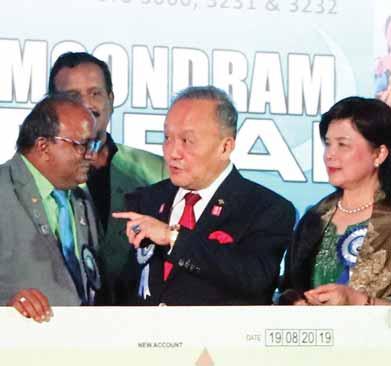


From L: DG G Chandramohan, TRF Trustee Gulam Vahanvaty, TRF Trustee Chair Gary Huang, PRID P T Prabhakar and PDG E K Sagadhevan promoting the End Polio Fellow programme.
million last year, the district is ranked fifth in the country. “We will propose two candidates for Rotary Peace Fellowship programmes. We have carried out signature projects like Sangamitra that provided basic sanitation and drinking water facilities in
governments schools; set up a bone bank and dialysis centres; and flagged off a cancer screening bus,” he said.


Membership and Foundation are the two eyes of Rotary and “we are doing projects on all the six focus areas in our district. Our Rotary Jeevan scheme, pending clearance from RISAO, will offer `2 lakh to the kin of the deceased Rotarians.
A Trust was formed to manage the district scheme,” said DG Dr Zameer Pasha, RID 3000. He thanked Gary and Vahanvaty for setting up the Rotary Disaster Relief Fund that provided an emergency grant of $25,000 to places affected by natural calamities. RID 3000 had set a target of $2.05 million in TRF giving this year.
Every Rotarian in RID 3231 will be asked to give at least $10 to meet the TRF target of $1.15 million, said DG Sridhar
Balaraman, RID 3231.
“We will take up global grant projects for over $200,000; give at least 6–7 Term Gifts; and set up three more dialysis centres.” Over the last two years, the dialysis centre set up by RC Vellore Fort had done 11,000 free dialysis cycles for needy patients. “From 17 machines, the Vellore facility will expand to 40 dialysis units.”
Cots and TV sets will be donated by the district Rotarians to owners of the newly-constructed houses at Kuyilkuppam village in Kancheepuram district promoted by the main donor PDG Abirami Ramanathan. After receiving the AKS pin and Service above Self Award from Gary, Ramanathan said, “From the day I joined Rotary in 1987, I started giving and have never stopped. Now I am giving another $100,000 without permission from my wife!”
Presenting a cheque for `1.04 crore to TRF, DG Dr A K Natesan, RID 2982, who is becoming an AKS member, said most of his clubs were in the rural belt spread across six revenue districts. “Our applications for 3–4 global grant projects were rejected following the adoption of a new community assessment which does not take into account the geographical disparities we are burdened with,” he said. They have set a target of $5 lakh in TRF giving this year.
Every Rotarian in RID 3232 will be contributing at least $2 for two polio drops in a unique fundraiser through a crowdfunding platform that aims to collect a minimum of $1 million for TRF’s Polio Fund. When added with Gates Foundation’s 1:2 grant of $2 million, at least $3 million will be given to Polio Fund by the end of

InBengaluru, Trustee Chair Gary Huang inaugurated a Rotary Cardiac Rehabilitation Centre at the Sri Jayadeva Institute of Cardiovascular Sciences and Research (SJICSR) in the presence of Trustee Gulam Vahanvaty, RI District 3190 DG Sameer Hariani, Director of SJICR Dr Manjunath, RC Bangalore Indiranagar President Manoj Agarwal and other club members. DG Hariani said this state-of-the-art centre was done as a joint project by RC Bangalore Indiranagar and SJICSR. The building is put up by the SJICSR, which is a State government institution, and the entire equipment is provided by the club through a $224,807 global grant,
June 2020. “$2 for 2 drops is also open to public and after the soft launch in August, we have collected over $10,000 so far,” said DRFC M Ambalavanan.
in collaboration with RC Santo Andre, RID 4420.
This centre will provide lifestyle change-counselling and training, diet consultation, evaluation of the entire cardiovascular system though ECG/ ECHO/TMT; physiotherapy units, respiratory therapy and training in yoga. The equipment that this Rotary project has put up in this 700-bed famous cardiac hospital includes high-end ECHO Cardiography machines, treadmills, latest physiotherapy and other equipment. Trustee Chair Gary complimented the club members for their meticulous execution of this project.
All India End Polio Flame consisting of two torches were lighted by Gary kicking off the K-to-K flame campaign to mark Rotary’s 100th year
in India. “On World Polio Day, Oct 24, the two flames will begin a pan-India rally from Kanyakumari to reach Kashmir by Mayend. While one torch will
be taken through western India, the other one will reach Kashmir after traversing the eastern regions. Each torch will be given to Rotary officials in Pakistan and Afghanistan by June 2020,” he explained.
Brand Avatar, an innovation from RID 3232, would create the “first ever human skyline in Chennai to attempt a Guinness Record on Jan 5, 2020. Our aim is to connect humanity in Chennai for causes dear to Rotary,” said PDG I S A K Nazar.
DRFCs S Gopal, RID 3000, and M Balamuralikrishna, RID 3231, listed out the annual goals of their respective districts. District Global Grant Chair PDG Chehab (Shab) El Awar from RC Las Vegas Won, RID 5300, and his spouse Bricia Shab and PRID P T Prabhakar were special invitees. Over 400 Rotarians and 300plus Rotaractors attended the TRF conclave.
Besides the $2 for 2 drops and K-to-K End Polio Flame, End Polio Now Coordinators E K Sagadhevan and Keshav Kunwar have jointly designed and promoted a new district recognition for members who donate $1,500 or `1 lakh to the Polio Fund. For every such donation, a special End Polio Fellow Pin will be given.
Pictures by V Muthukumaran


Ni hao, Rotarians!
Friends, World Polio Day is commemorated this month and we are facing a major challenge. The news out of Afghanistan and Pakistan tells us that we have more work to do. It tells us that polio will not die out quickly or easily.
Most of all, it tells us that we are needed now more than ever. Success will require us to remain steady and show that there is no time limit to our commitment. We are in this to the end, and we will conquer this terrible disease. We will give life back to children and families, and restore hope to communities.
We are fortunate to have great friends in the Global Polio Eradication Initiative — including the Bill & Melinda Gates Foundation, which continues to match every donation 2-to-1. We have already eradicated wild poliovirus type 2, and type 3 could soon be wiped out. India is polio-free. All of Africa may soon be polio-free.
The most important factor in ending polio forever is you. The people of Afghanistan and Pakistan have faced so much hardship in recent years. Polio is just one more challenge. To them, it could all feel overwhelming. But not to Rotarians. We do not feel overwhelmed. We feel challenged, and, as people of action, we rise to challenges.
In the words of Confucius: “If one is virtuous, one will not be left to stand alone. It is certain that associates of like-mind will come and join with one.” In Rotary, we understand these words very well. When we say “Service Above Self,” we take a stand for this virtue. We know that our like-minded brothers and sisters around the world will join us. We have been drawn together by our need to do good in the world.
We can rid the world of the disease forever. And you will be the ones to do it, through your continued commitment and generosity.
Be a part of history! Help us overcome the final hardship, the final challenge. Make your donation at endpolio.org/donate.
This Rotary Year, I’ve visited several Global Grant (GG) projects. I recently accompanied Trustee Chair Gary Huang and witnessed the humanitarian work that clubs and districts are doing with GGs making life-altering changes to communities in need. Of these, I highlight just two; low-cost shelters in Kochi built for the homeless after last year’s devastating floods. Families are moving into their new homes with renewed hope and pride. The second is a dialysis centre in Hyderabad that caters to the poor by charging just `300. The local gurdwara owns the building and has given the space free of cost; the centre is run by the Mahavir Foundation and the equipment is provided by TRF — a unique partnership indeed. Another project is not a GG but needs special mention: the South Eastern Railways have entered into an MoU with RID 3150 where a small portion of railway platforms will be earmarked for Rotary to set up kiosks for mothers to breastfeed in complete privacy. This is an excellent service to the community and, incidentally, great PR for Rotary.
But, as a Trustee I reiterate that we need to be more concerned with stewardship. We are dealing with funds given by donors and like Caesar’s wife need to be beyond reproach. We need to ensure that the use of TRF funds is above reproach. Not for nothing has TRF earned the highest accolade of four stars for the 12th year running by Charity Navigator.
We sometimes say, “God lies in the details” — a way of saying what worked to perfection. We also say “The devil lies in the details” when something does not work as planned. Sounds similar but the difference is between heaven and hell.
As a wise man said, “Trust starts with truth and ends with truth”. Let that be the motto for all Rotarians and Rotary clubs.

Gary C K Huang Foundation Trustee Chair
Gulam A Vahanvaty Trustee, The Rotary Foundation
Rasheeda Bhagat
Way back in 2010–11 when we in Rotary first dreamt of making India literate, I had said it is probably the most important thing we Rotarians can do for our country,” said PRIP and RILM Chair Kalyan Banerjee at the Ignite session in Kolkata.
And towards this goal, he chose RIPN Shekhar Mehta for this cause because “having known him since 1995, long before he became a district governor, I knew that if you had a job to be done — give it to a crazy fanatic like Shekhar. And he will never stop till the work is complete, and done perfectly too.”
By 2014 he had come up with the concept of TEACH — Teacher support, E-learning, Adult literacy, Child development and Happy school. This was an “amazing and comprehensive” project because it included all the core components of education. While other NGOs working in this area had picked up one or two of these thrust areas, Rotary was ready to do all of them.

“The team that the Rotary India Literacy Mission (RILM) gathered was special, dedicated and committed and Rotarians pitched in everywhere. Things fell into place, he gathered a core group to manage the correspondence, the queries, and then they selected a brilliant, enthusiastic, committed group of Rotarians.”
These people were passionate about making the country literate and the juggernaut moved on. With or without the resources provided through RILM, the clubs moved on, often raising funds on their own “because they loved literacy and wanted their community to be literate. At the same time, holding hands with RILM and the Rotary clubs, the Government of India and all other literacy-oriented NGOs got involved,” said Banerjee. Urging the assembled governors and other senior leaders, most of them PDGs, on various committees, RIPN Shekhar Mehta said the goal was to make India totally literate by 2025. “And to do that we have to replicate what we did with polio. If polio was a dream that was large, then making India literate is larger than the largest dream. It is very complicated, challenging and difficult.”
But thanks to the research the RILM team had done in the first year, it was able to design a programme where “till date no government or NGO has said that you have gone wrong here. That is because we took ideas from all stakeholders, government, bureaucrats, experts, both domestic and international NGOs and then designed the TEACH module.”
This project took off, said Banerjee, “thanks to the robust structure of the programme and its wide and comprehensive reach, covering all the crucial components of literacy. Thanks to the efforts of PRID Sushil Gupta as TRF Trustee, CSR funds can be used for Rotary projects. While clubs and districts take up literacy projects at their levels, the RILM committees take initiatives at state, central and corporate levels.”
While the exact date for making India literate can’t be predicted, “we shall keep going until each State is 90-plus per cent literate and until the GoI says we are literate country.”
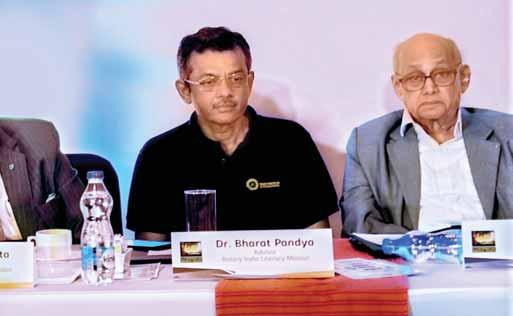
The “icing on the cake” was RIDs Bharat Pandya and Kamal Sanghvi, who were always working for literacy “quietly, join the party in a big way. Now, with all of you… the flutists, the trombonists, the violinists, the drummers, the full orchestra is at play. As Bharat helps make Bharat literate and as Kamal does his kamaal, literacy in India is set to rise to its peak or Shekhar (Shikar), if I may say so! And I will be here on the sidelines to bless you and say kalyan ho.”
Addressing the meet, RIPN Shekhar Mehta said, “No NGO in the world looks after all the three major components of literacy — child, teacher and the environment (school). Add to this those who didn’t go to school or adults. There are approximately 100 PDGs involved in this programme, 10 Zonal Literacy Chairs, and TEACH and fundraising committees, with 15 members each. In which other programme have you seen this passion, and so much work happening in such a short time?”
In E-learning, RILM had struck partnerships with the State governments
of Gujarat, Maharashtra, Punjab and Madhya Pradesh. But the big news of the morning was Mehta’s announcement that “very soon, hopefully, we will have a programme with the GoI, along the lines of polio. The draft has been approved by the NITI Aayog and is now with the Cabinet.” Once this MoU is signed with the GoI, this “will be the biggest step anybody has taken towards making India literate.”
But this was a huge dream and required great dedication and extreme hard work, he cautioned the participants. “The DLCCs’ (District Literacy Committee Chairs) role is a very
serious one. If anybody is not serious, then please give your resignation as this is a mission for our country, and we have made a commitment to the HRD Ministry. The literacy project is not for weak-hearted people. If you cannot dream big, or take up challenges, this programme is not for you.”
Apart from Literacy, the two other areas of focus for him are Positive Health and WinS. During his interview for the RI President’s post, Mehta disclosed, he had been asked his vision for Rotary in 10 years. “I said I want Rotary to be the No 1 service organisation in the world. And I said this on behalf of all of you. But we can’t do that by just working on literacy.” By working for positive health and water and sanitation, along with literacy, Rotarians would cover all the crucial focus area of Rotary, Mehta added. And for all the three verticals of literacy, health and WinS, special committees have been formed.
Vice-Chair of RILM and RID Sanghvi, said the “the great dreamer Shekhar” (Mehta) had set a goal for making India literate by 2025. “It is difficult but possible. Mahatma Gandhi had said if you want to wage a war, wage it against illiteracy. Let’s do that

Shekhar Mehta said that today India’s literacy stands only at 74 per cent, but 96 per cent of our children go to school. “Then why are we still at 74 per cent? This is because we have a whopping number of 25 crore adult illiterates!
The pity was that in the next census, this number might still remain illiterate, taking the outer limit of our literacy rate to 80 per cent at most, he said.
“Our programme with the GoI is to strike at the heart of this and if we can reach out to the numbers we want to, our literacy rate will jump from 74 to 90 per cent. And if you cross 90 per cent, you are among the literate nations of the world. This is possible but it needs your passionate involvement and hard work. This year’s governors are here; but even though they had a shorter time of only 10 months as Ignite was being held late this year, they should start training for literacy in their districts
immediately, “because at the core of RILM success is its training.”
Mehta added that at the just concluded executive committee meet “we’ve decided that by 2025, come what may, Rotary India will put its best efforts to make India totally literate, which means taking the literacy rate up to the 95 per cent level.”
With two “outstanding and young RI Directors in Bharat Pandya and Kamal Sanghvi, who complement each other’s style, we will move speedily towards this goal. Bharat has been a master trainer for RILM for years and Kamal has been its Vice-Chair.”
The next week two more warriors — whoever they may be (RI Directors for 2021–23) will join this cause. For two years I may be a little away from you but I will be in the hearts of everybody who works for literacy. Whichever part of the world I might be, I promise you that I will keep working for literacy.”
in every town, village and street of India and work for an India that is at peace with itself and among the best in the world. Let us make history and bring change, one pen, one book, one teacher, one school at a time.”
As “the governors drive everything in the districts, make sure you give direction to the clubs, and set goals; if you don’t set goals, nothing substantial can be achieved.”
During the goal-setting exercise for Asha Kiran, he began with a goal of the districts sending 15,000 children back to school, which many DGs said was “too low”, and said each district would send back 1,000 children back to school during this Rotary year.
RI Director Bharat Pandya said that the “grand vision of literacy was conceived eight years ago by PRIP Kalyan Banerjee, and Mehta has made it his mission to see that this vision was fulfilled.” Making a detailed presentation of the five elements of TEACH, he urged the clubs and districts to add the local language to the RILM module, and

RIPN Shekhar Mehta and RID
Kamal Sanghvi with members of RILM’s Fundraising Committee.
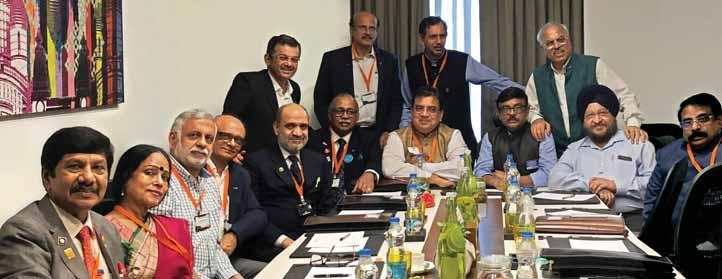
ensure there is 90 per cent animation, as this engages the students and help “better retention, comprehension and attentiveness. The teachers also find it easier to teach these modules.”
Both Mehta and Pandya stressed the importance of reporting; many clubs were doing excellent work on different components of TEACH, but if this was not updated on the central RILM website, the overall impact of the work Rotary does can’t be leveraged for government, corporate and other partnerships.

He said a world at peace needed two components — absence of war and conditions in societies that are conducive for peace. “Of the estimated 68.4 million refugees in the world, a large majority are from countries with low literacy levels. The cost of violence to the world economy is said to be $14.7 trillion.”
While literacy was an important key to unlock the future of all our youth, “I’d urge you to focus on the girl child. Our girls and female population have been discriminated against and we will have to do some reverse discrimination to repair this. The best ornament for a girl is not a necklace or a diamond but education as it has the potential to transform not only her life but the life of her entire family,” Pandya said.
A well-educated girl grows up into “a properly informed independent individual who can make decisions about her own life, career and family.” An educated female population would be a game changer for India.
Both he and Sanghvi were with the governors to help them become “the torchbearers of literacy in the next 10 months. Let us all work hard to take literacy rate beyond 95 per cent by 2025. That is not unachievable; literacy will
take India on the path of progress and development.”
The Director added that this was one project where CSR funds “will work; children’s education is an area that appeals to the hearts of everybody.” He commended RC Bangalore, RID 3190, for doing 106 Happy Schools. “Imagine a single club has done such an excellent and outstanding work. Both Shekhar and I have visited those schools, which have benefited over 16,000 students.” Last year RC Bangalore Orchards, under the presidentship of D Ravishankar, did a record number of 126 Happy schools.
Mehta added in a lighter note: “You can see Bharat Pandya’s passion for the literacy project; of course, he has been our chief trainer, but the other secret is that Madhavi (his spouse) had done 50 Happy Schools during her term as the Chair of her Inner Wheel District!”
He said that any club or district that wanted to set up a school library should get in touch with RILM and it could help them get books at great discounts. Also, while renovating schools, those who had contacts with corporates dealing in cement, pipes, steel, paint, sanitaryware, school furniture, etc should alert RILM, as bigger order could get mega discounts.
Pictures by Rasheeda Bhagat
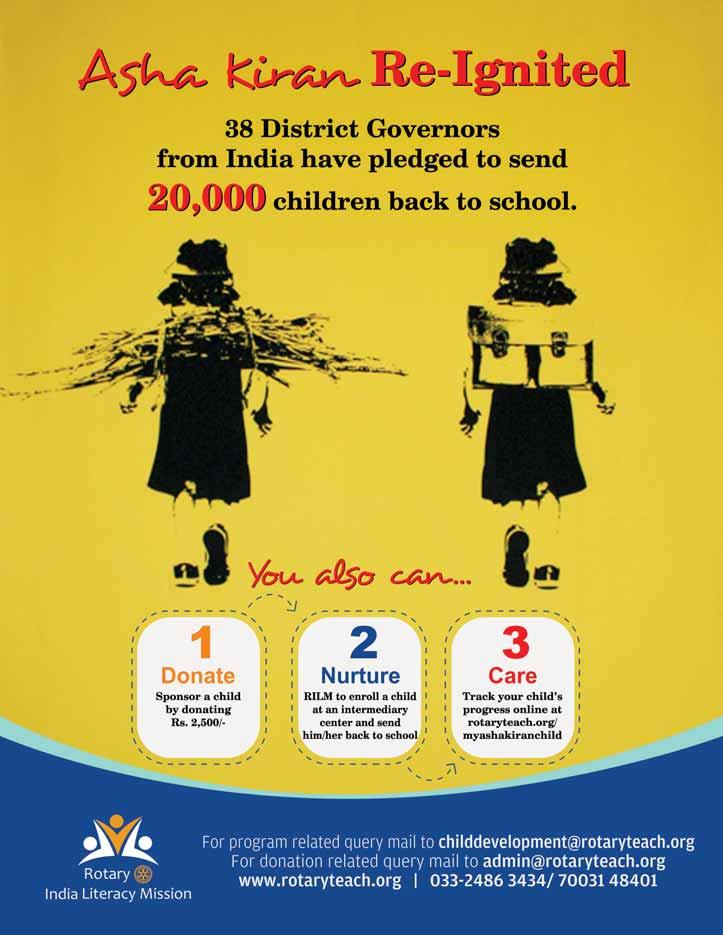
Rotary International
President Nominee Shekhar Mehta recently flagged off and participated in the ‘Great Ganga Run’— an endeavour organised by the National Mission for Clean Ganga (NMCG) under the Ministry of Jal Shakti of the Government of India to create awareness among the public for water conservation and river rejuvenation. “The cause itself is outstanding where we are talking about rejuvenation of our great rivers which are the source of livelihood, ecology and flora and fauna. In fact, the very existence of people depends on these rivers,” he said.
The programme saw 16,000 participants, including 2,000 Rotarians, Rotaractors and Interactors, at the Jawaharlal Nehru Stadium in Delhi in categories to cover 21 km, 10 km, 5 or 2 km.


The Union Minister for Jal Shakti Gajendra Singh Shekhawat, Minister for Youth Affairs and Sports Kiren Rijiju and Minister for Jal Shakti Rattan Lal Kataria, along with several other government officials, participated in the Run.
Rotary Club of Delhi Ashoka, RID 3012, sponsored T-shirts adorned with Rotary logo for the participants. PDG Ramesh Aggarwal coordinated the event for the Rotarians.
Rotary is closely associated with the Clean Ganga initiative since 2017 when PRID Sushil Gupta, who was then the WinS Global Chair and PRID P T Prabhakar (then WinS ViceChair) signed an MoU with the NMCG to support the government’s mission to save the Ganga and other rivers from excessive pollution.
In 1999, four young and idealist doctors from AIIMS, Delhi, came to Bilaspur to establish a rural centre for medical care in the Achanakmar forest area, located around 30 km from Bilaspur in Chhattisgarh, which has many tribal villages. They found some land, leased it and built a hospital in the village Ganiyari, located midway between Bilaspur and Achanakmar, establishing an NGO called Jan Swasthya Sahayog (JSS). Its primary objective was to provide quality healthcare at a very affordable price in a region bereft of decent medical facilities for the underprivileged. The head of the group Dr Raman Kataria, is a paediatric cardiac surgeon.
The JSS has been doing “yeoman service in catering to the social and healthcare needs of this deprived
population in a region which has many healthcare challenges,” says Dr Devendra Singh, past president of the Rotary Club of Bilaspur Midtown, RID 3261. He is a senior consultant gastroenterologist at the Apollo Hospitals. He says that the JSS runs regular outpatient clinics and provides inpatient services by charging a very nominal fee — only `10 for an out patient and a highly subsidised rate for inpatient care. “While they are able to offer primary and secondary-level healthcare by generating their own resources, the doctors found it very frustrating when the patients needed tertiary healthcare.”
This was compounded when they saw large numbers of children coming with rheumatic heart disease (RHD) at their Saturday cardiac clinic. Dr Singh
explains that RHD is caused by an infection that first affects the throat, and is “a crippling cardiac condition which selectively targets cardiac valves causing progressive damage, leading to congestive heart failure and premature death. While many of the affected patients can be managed adequately by supportive treatment, Dr Kataria found that a good number had advanced cardiac disease which required urgent cardiac surgery,” says Dr Singh.
Such patients require either a single or double valve replacement, and the cardiac surgery was far too expensive to be affordable to the parents, “most of whom are either marginal farmers or daily wage earners and practically everyone is below poverty line.”


When the JSS chief, Dr Kataria, discussed this dilemma with Dr Singh, the latter reached out to some Indian doctors in the US and the possibility of a TRF grant was explored. Persistent efforts saw the materialisation of a matching grant project worth $45,000 from 2013 to 2016. This was jointly implemented by RC Trans Arpa Bilaspur (since then shut down) and RC Orlando Evening, RID 6980, US. The former president of the international partner club, Dr Karuna Sabharwal “was highly supportive in facilitating the entire process. With this money, we did 19 cardiac surgeries on underprivileged RHD patients of the area,” he says.
But then this was not enough, and the need for such surgeries was much more in the region and the JSS wasn’t able to help many needy patients with advanced cardiac problems. “So once the matching grant was done, I got in touch with the same group of dynamic Rotarians — Karuna Sabharwal, who is the RI Foundation Chair of RC of Lake Buena Vista, Florida, in early 2017 and Dr Satish Goel, an eminent cardiologist of Indian origin based in Jacksonville, Florida. They were highly supportive during the application process, and our work fructified in another global grant.”


The host club was RC of Bilaspur Midtown and the international sponsor was RC Lake Buena Vista, Florida, RID 6980, US. This time it’s a $72,000 grant and “we planned to do 50 cardiac surgeries with this grant money. Of this, 37 cardiac surgeries have been done,” said Dr Singh.
The patients are picked up from weekly cardiac clinic of JSS headed by its physician Dr Y S Parihar and his team. They are further interviewed and a repeat echo cardiography is done by Dr Satish Goel through skype, from his Jacksonville office. After final selection and counselling, the patients are transported to Sankalp Hospital in Raipur, accompanied by JSS volunteers. There the operations are done at a subsidised rate of less than `1 lakh by Dr Nishant Chandel, a renowned cardiac surgeon in the region.
One of the beneficiaries (in the picture) is 16-year-old Gauri, who had to drop out of school because of palpitations and shortness of breath. “After surgery was done, she is fine and now, after a gap of four years, she will soon be rejoining school,” said Dr Singh.
Prahlad, 17, (in the picture) the son of a daily wage earner, was picked up from an outreach clinic run by JSS deep in the forest region. He had advanced RHD and required double valve replacement, but due to abject poverty could not get the surgery done. “After
counselling and assurance by our team that everything will be taken care by Rotary and JSS, the family agreed to the operation and now he is back to normal life. Sadly, however his father died two weeks back from an illness,” said Dr Singh.
Two TRF grants
“We will complete this project in the next six months. Through these two grants, Rotary has truly brought smiles back on the faces of patients and given them a new lease of life. Moreover, as bioprosthetic valves are used on these patients, they do not require follow up anticoagulation therapy. They are regularly being followed up in JSS clinics and all are doing well and are back to normal life,” added Dr Singh.
On the importance of a TRF grant, Dr Singh said, “When Dr Kataria contacted me and I got in touch with some common friends in the US, they were willing to help, but only through a credible agency. That is where Rotary came into the picture. Our partners are very happy. Last fortnight they requested us to sponsor a global grant for an American project on human trafficking where they will educate American children on the dangers of human trafficking. It is a multi-district project for which we are the sponsor club and will do the auditing of their work!”
V Muthukumaran
Moved by the plight and agony of underprivileged girls at government schools who had to miss classes, with some even dropping out from school, due to lack of menstrual hygiene facilities, Sugirda Nishanth from RC Madras North, RID 3232, initiated Project Kannamma in August 2018. It began with the giving
of sanitary pads and undergarments to 82 girls at a Government High School, Uthandi, near Chennai, along with regular medical check-ups, says Sugirda, Project Chair.
During her interaction with girls, she found that they used dirty rags, hay, dry leaves and even ash wrapped in covers and other crude alternatives for want of affordable pads during

menstruation. “Apart from urinary tract infections, the hapless girls were also exposed to the risk of cervical cancer. Worse, they were not aware of the harmful effects of using such means during menstruation,” she recalls. A State-level carrom player had to skip a national meet and some top-scoring girls were not able to concentrate on their studies, all for want of access to




safe, quality pads during menstruation. Project Kannamma reaches out to over 1,500 school girls with free sanitary pads and they were also exposed to ‘motivational talks’ by Rotarians and experts on menstrual health management (MHM).
Now, Kannamma pads will be distributed to thousands of girls in deprived areas, slums and marginalised societies in and around Chennai, thanks to the Sathyabama Institute of Science and Technology Chancellor Mariazeena Johnson, who has donated `3.5 lakh for the purchase of a sanitary pad making machine from ‘Padman’ Arunachalam Muruganantham.
Dr MGR-Janaki College for Women Chairman Rtn Kumar Rajendran has provided the space in this college to set up the vocational centre.
“Initially, this centre will produce 40,000 pads in a month in a single shift. Out of this, we intend to



set aside 8,000 pads (1,000 packets) for free distribution. The rest (32,000 pads) will be sold at an affordable rate of `25 for a pack of eight pads.”
In a touching gesture, RI Director Kamal Sanghvi called on all the six speech and hearing-impaired girls who are employed at the pad making unit and feted them by pinning special badges on them during the inauguration of the vocational centre on the premises of Dr MGR-Janaki College of Arts and Science for Women. He announced that his home district (RID 3250) will sponsor 50 per cent of amount to set up two such pad-making centres if clubs in Chennai were ready to replicate the model adopted by RC Madras North.
He urged Sugirda to give a feedback report on the livelihood status of girls employed at the centre after they started working here. “The girls studying in this college must also put in volunteer hours at the centre and distribute pads to the poor for a healthier society,” he said.
In his address, PRID P T Prabhakar said the MHM was part of Global WinS project (chaired by him) in
which Sanghvi was the Liaison Director. “In Chennai alone, around 100 tonnes of waste is being generated through commercial pads on a daily basis and hence, it is critical to produce eco-friendly, safe and cost-effective pads for mass consumption.”
He requested Sanghvi to replicate Project Kannamma in at least 100 Rotary centres for a concerted drive to usher in menstrual hygiene among school girls in India. RID 3232 DG G Chandramohan said the vocational centre will further enhance the reach of Rotary among school girls and provide them with hygiene solutions. He called upon the club to explore the possibility of setting up such need-based vocational centres in other colleges and institutions across Chennai.
PDG G Olivannan, Project Advisor, RC Madras North President M Ganapathi, Secretary John Frederick, State BJP General Secretary Vanathi Srinivasan and retired IPS officer and legislator R Natarajan spoke on the occasion.
Pictures by V Muthukumaran
North Karnataka experienced heavy rainfall in early August this year disrupting normal lives. In areas around Hubli-Dharwad it was reported that the rainfall was the highest in the past 30 years. Alnavar taluk was badly affected with most of the rural houses inundated with water.
“We were saddened to see collapsed huts and people there had lost almost everything except their lives. Their bleak faces were heart wrenching,” said PDG Ganesh Bhat, RID 3170. The district office sprung into action and formed the ‘Rotary Hubli-Dharwad Disaster Relief Task Force’ under the leadership of DG Dr Girish Masurkar.

Through a slogan — Each one, Adopt one — the district Rotarians were urged to support the victims. Rotarians of Hubli, Dharwad and
Gokak responded to the call and pooled in money and material to help the villagers.
“We placed an order for 100 Shelter

Kits with RC Calcutta Mahanagar, RID 3291, and received them within four days,” he said. With the help of the local District Commissioner, Assistant Commissioner, the Tahsildar and Town Planning CEO, needy families were identified in Alnavar and Gokak villages and the kits were distributed.
The flood waters had ruined the books and bags of school-going children.
“So with a slogan — Return to School — we gathered uniforms, shoes, stationery and school bags from Rotarians and distributed them to the children in these villages,” said Bhat.
Rotary Foundation (India) rewarded
The CSR team at RISAO had nominated Rotary Foundation (India) to the UBS Forums for Rotary’s polio eradication efforts. RF (I) has bagged two awards as ‘Most Committed NGO’ and ‘NGO of the Year’ at the CSR Summit and Awards 2019 held in New Delhi.
The UBS Forums aim to develop transformational leadership for individuals and industry through panel discussions and thinktank sessions to actively engage participants beyond the traditional one-way information stream.
AKS members as of Aug 2019
Nirav Shah and Devina (RID 3141) and A K Natesan and Parvathy (RID 2982). They are members of the Trustees Circle.
2019–20 Fundraising goal
The fundraising goal for RF (I) for 2019–20 is $30 million. To commemorate Rotary India’s centennial year encourage clubs to do impactful projects in communities and raise funds to surpass the goal.
Rotary’s privacy and security policy for personal data
RI and TRF (collectively referred as “Rotary”) have adopted the Privacy Policy (“Policy”) governing collection, access and retention to personal data. The purpose of this Policy is to:
Define what constitutes personal data for the purposes of this Policy
Establish the various classifications of data based upon its sensitivity
Establish minimum requirements for collecting, accessing, sharing and storing personal data
Establish the process for reporting a personal data security breach
Identify who is responsible for protecting personal data.
This Policy applies to Rotary employees and all those who have or are granted access to personal data. It is the responsibility of all to help maintain the confidentiality, integrity and security of personal data. More information on Rotary’s Privacy Policy can be found at https://my.rotary.org/ en/privacy-policy.
In the past, thanks to the generosity of donors, RF(I) had adequate funds, to disburse TRF grants from RF(I)-INR account. In 2018–19, we funded more grants in India than we did in the prior year 2017–18, along with PolioPlus activity in the region. While we were delighted to see this increase in grant activity, it also meant that we spent the RF(I)-INR funds much faster than anticipated.
We expect that the number of grant disbursements may considerably
increase this year (2019–20) over last year. To meet the possible funding gap, RF(I) has decided to disburse grant from the RF(I)-FCRA account to those districts/clubs that are FCRA registered.
Therefore, districts and clubs registered under FCRA must forward their FCRA registration and renewal certificates to Roy John at roy.john@ rotary.org to ensure prompt grant payments.
Participants can now earn virtual badges and follow a learning plan to take a series of courses on a role or topic.
For example, each club officer role now has a learning plan that includes updated material and manuals. Club presidents will find a manual for their role in the Learning Centre. Be sure to promote these new resources to club officers — Club President Basics; Club Secretary Basics; Club Treasurer Basics; Club Membership Committee Basics; Club Administration Committee Basics; Club Public Image Committee Basics; Club Service Projects Committee Basics; and Club Rotary Foundation Committee Basics.
Head - TRF Sanjay Parmar and Senior Programme Associate Bhavna Verma receive the award from VP, Head of Communications - Corporate Affairs and CSR, Nissan India Abhishek Mahapatra.
Update the old Learning Centre address to navigate to the new site, Rotary.org/ learn.



Here are a few courses to consider — Rotary Club Central Resources that includes video and how-to guides for setting goals and understanding trends; and Membership courses to promote new strategies for recruiting members and enhancing clubs.
It gives me great pleasure to be back in Manipal exactly after 10 years. Rotary is not about power or position. It is the service that we do to humanity and I congratulate every Rotarian of the club for bringing such magnanimous transformation in your society in these 60 years,” said PRIP Kalyan Banerjee,
addressing a gathering of past and serving governors of RIDs 3181 and 3182, and several other Rotarians and their families at the Diamond Jubilee celebrations of RC Udupi Manipal, RID 3182. He urged the club to induct young members and women. “We are looking at young potential members who have
a burning desire to move ahead faster and take up Rotary as a model. Women are also marching ahead, competing with men, and usually doing better,” he said.
Commemorating the special year, the club distributed e-learning kits worth ` 8.8 lakh to schools and sewing machines to 120
underprivileged women. Infrastructural facilities were enhanced at the Ajeevanagara Higher Primary School in Manipal. “Our club has given five governors. We are keen on promoting literacy and WinS — the two aspects which will make a huge difference for children and the community,” said the

Diamond Jubilee Club
President Amit Aravind.
Event Chairman PDG Dr H Shantaram gave an account of the club’s notable projects over the years. The Rotary Sports Complex constructed at the Manipal Cooperative Society has been a boon for schoolchildren.
The Rotary Centenary Ward set up in the Shirdi Cancer Hospital in 2005, equipment donated to the ophthalmology department of the Kasturba Medical College in Manipal and a gene expert machine worth `25 lakh for diagnosis of tuberculosis at the District Government Hospital in Udupi are few of the projects executed by the club for healthcare. Besides, the club has provided toilets, wash stations and

IPP Amit Aravind, along with members of RC Udupi Manipal, provides wheelchair to a physically-challenged woman as part of the club’s diamond jubilee projects.
water purifiers in schools and distributed atlases and dictionaries for high school students.
“Each of our members pitched in to help the Kerala flood victims and for Rotary’s ‘Rebuild
Kodagu’ programmes,” said Aravind.
DG B N Ramesh urged the Club President Rajavarma Ariga and Secretary Shreesha Hegde to lead the club to newer heights and recalled how
Geetha Kausik won 33 awards during her presidential tenure. “If your club grows, Rotary grows. Make a plan and set the goal. Focus on your goal and you will succeed,” he said.
Here is the updated Rotarian Code of Conduct; the last aspect has been included since Jan 2019.
As a Rotarian, I will:
Act with integrity and high ethical standards in my personal and professional life
Deal fairly with others and treat them and their occupations with respect
Use my professional skills through Rotary to: mentor young people, help those with special needs, and improve people’s quality of life in my community and in the world
Avoid behaviour that reflects adversely on Rotary or other Rotarians.
Help maintain a harassment-free environment in Rotary meetings, events, and activities, report any suspected harassment, and help ensure non-retaliation to those individuals that report harassment (January 2019 Mtg., Bd. Dec. 119).
Source: COL 89-148; Amended by May 2011 Mtg., Bd. Dec. 204; September 2011 Mtg., Bd. Dec. 87; October 2013 Mtg., Bd. Dec. 31; January 2014 Mtg., Bd. Dec. 88; October 2014 Mtg., Bd. Dec. 60; January 2019 Mtg., Bd. Dec. 119
TheRotarians of RC Hyderabad Deccan, RID 3150, donated a cytometer to the Basavatarakam Indo-American Cancer Hospital and Research Institute in the city in the last week of June. The medical equipment will be used to diagnose ‘acute lymphoblastic leukaemia (ALL)’, blood cancer in common parlance, in children. The hospital treats about 12,000 cancer patients annually. DG (2018–19) Ramesh Vangala inaugurated the facility at the centre. The project, costing `66 lakh, was executed with support from RC Naperville, RID 6450, USA, and TRF. Uday Pilani, IPP, RC Hyderabad Deccan, said that the

cytometer services, which otherwise costs `25,000 for a sitting, will be extended free of charge for children hailing from underprivileged families. It will help doctors to determine the exact dosage

of medication depending on the extent of the disorder in each child. The facility will also be used by the MNJ Institute of Oncology and Regional Cancer Centre (MNJ) which is the sole referral hospital that treats leukaemia in children across the States of Telengana, Andhra Pradesh and northern Karnataka. The centre provides medical oncology and palliative care services free of cost to all patients below
poverty line. More than 10,000 new cancer patients are registered every year and 110,000 patients come for follow-up, totalling to 120,000 patients a year.
“We were on a hattrick,” said Pilani, adding that this is the club’s third global grant project in the last three years. The first global grant project was a 12-bed dialysis centre costing `1.18 crore at the Mahavir Dialysis Centre in Secunderabad and its second project upgraded the Rotary Blood Bank at the Challa Hospital in Hyderabad by providing a state-of-art mobile blood collection van at the cost of `68 lakh.
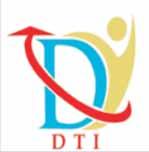



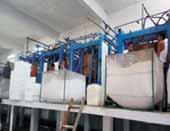




V Muthukumaran

Rotary Club of Madras Bay City, RID 3232, recently organised an All-Faith Memorial Service at the Anna University campus in Chennai. “Through this solemn ceremony, we are spreading the message of the supreme sacrifices of our soldiers to the citizens, especially the youth, and reassure the serving officers and veterans that their sacrifices would not go in vain,” said DG G Chandramohan, speaking at this memorial service being held for
the eighth consecutive year. He thanked Professor M K Surappa, Vice-Chancellor, Anna University, for hosting the special event which was attended by NCC cadets, students and faculty.
Delivering his address after laying a wreath, Rear Admiral K J Kumar, Flag Officer Commanding, Tamil Nadu and Puducherry Naval Area, said the soldiers and officers of the defence forces were the ‘torchbearers of secularism’ for they come from diverse backgrounds
and perform duties with ‘great passion’. Academic institutions have to inculcate patriotism among the youth by holding events that highlight the arduous tasks of soldiers and personnel in guarding the country’s frontiers on land, at sea or in air, he said.
Kumar also called upon the media to portray the gallantry of the Armed Forces and “celebrate their heroism, rather than focusing on controversial issues, as this will go a long way in inspiring the youth to join the defence services.”
Vice Admiral B Kannan, CEO, Larsen and Toubro Shipbuilding, referring to the newly inaugurated National War Memorial near India Gate in Delhi, said, “you will experience a lump in your throat and your eyes well-up when you go through the inscription of the names of over 25,000 soldiers martyred during many wars the country had fought since Independence.”
Recalling his tenure as DRDO Chairman, S Christopher, an alumnus of the institute, said, “many people
don’t know the daunting circumstances in which our Armed Forces operate to guard our nation.” He could not even breathe properly or move around freely at a highaltitude military lab in Leh, “but our soldiers man these heights with singular devotion.” From a missile test-launch by a submarine off Vizag to fitting AWACAS aircraft with an electronic device, “I found it very tough to reach the spot and try to be my normal self.”
Commodore K P Ramachandran, IPP, RC Madras Bay City, anchored
the memorial service and Club President Suresh Krishnaswamy gave the vote of thanks.
RCs Chennai IT City, Madras Central Aadithya, Chennai Spotlight, Guindy, Anna Nagar Aadithya, Chennai Prestige and Madras Vadapalani co-hosted the event. PDG
I S A K Nazar, club presidents and Rotarians were present along with around 250 NCC cadets and students at the event.
Russian Consul General Oleg N Avdeev and Japanese Consul General Kojiro Uchiyama were special invitees.
Social forestry
DG Chandramohan planted saplings on the campus to kick-off a social forestry scheme which involves growing trees in gated communities and institutions. “We have planted 20 saplings on the campus to begin with and will ensure their proper upkeep. This green drive is part of our ROOTS (Rotary organised ownership of tree systems) project and hopefully, this will gather pace once the groundwater table is recharged after the monsoon rains,” said Krishnaswamy.
RCPanvel Elite, RID 3131, recently conducted an ENT screening and treatment camp, third one in successive years, at the Patwardhan Hospital. The camp was done in partnership with the RSS Janakalyan Samiti. “Dr Prakash Golecha from RC Jaipur East (RID 3054) helped us carry out this project successfully and at a significant scale by examining patients. What made this camp standout from others was that all the treatment was done without surgeries and on the spot,” said Club President Ritesh Munot. Highlighting some of the significant achievements during this camp, which was attended by 150 people, Munot said that a 94-year-old patient, who suffered from hearing loss, achieved significant improvement in his

hearing on the spot. “Another woman patient had her eardrum placed in the right position without surgery, and this brought her hearing sensation back. Earlier, she could not hear anything.”
Usually, he added, it costs around `50,000 for an eardrum placement; “but we were able to offer this procedure for free without any incision or surgery. That was a big achievement for us as a club.”



When you make your plans to attend the Rotary International Convention in Honolulu, from June 6–10, consider adding a few days to your trip to venture beyond Oahu and take in the splendours of its neighbouring islands.
On Kauai, nature lovers will fall in love with Na Pali Coast State Park (pictured). Pali means cliff, and you will find some thrilling ones, dotted with waterfalls, in the valleys along the coast. You might recognise this coastline from Jurassic Park; parts
Hank Sartin

of the film series were shot here.
On Maui, you can drive the Hana Highway, a 64-mile route that hugs the north coast from Kahului through the tiny town of
The road has over 600 hairpin curves and 46 onelane bridges. If you want to focus all your attention on the landscape, you can take a tour bus and let someone else worry about the driving.
And on the Big Island, you can see nature’s raw power in Hawai‘i’ Volcanoes National Park. Visit nps. gov/havo for updates on the volcanoes in the park. While you are on the Big Island, visit the coffee-growing Kona region to see the careful cultivation behind your morning cup of joe. Many coffee farms offer tours, and it is worth taking more than one to get a fuller picture.
Don’t miss the 2020 Rotary Convention in Honolulu. Register at riconvention.org by Dec 15 to save.

IPDG Mukul Sinha inaugurated a deep tube well set up by the Rotary Club of Rabindra Sarobar, RI District 3291, at a home for differently-abled children at Saltighat, Kolkata. Home to 300 children and adults, the campus suffered from acute water shortage. Voice of the World, an NGO that runs the home, approached the club for help. With support from the Eastern India Rotary Welfare Trust and RC Central Melbourne, Australia, RI District 9500, the club installed the tube well at a total cost of ` 1,43,000.
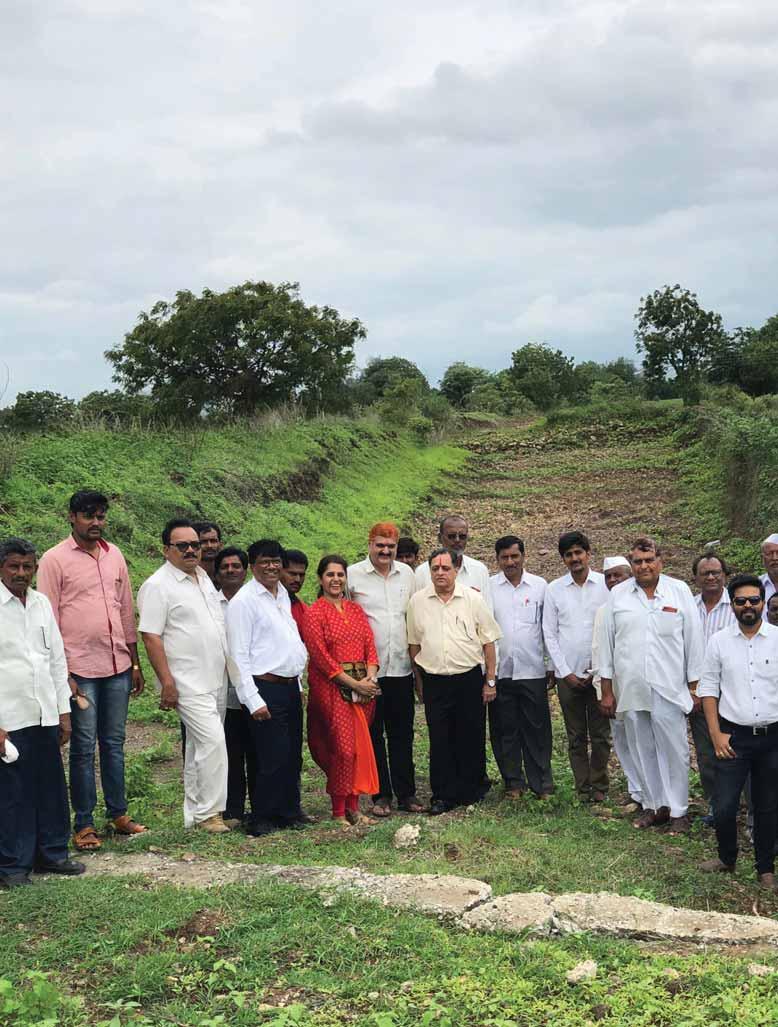

The clouds are hovering in the sky and there is an intermittent light drizzle as we drive from Solapur in Maharashtra to the little town of Omerga, where Deepak Pophale, when he was the District Governor of RI District 3132 during 2015–16, has ushered in a mini-revolution of sorts in water management.
Accompanied by Pophale, who is a member of RC Omerga, other Rotarians from the club and PDG Rajiv Pradhan from the same district, we set out to see the clutch of water conservation projects this club has done in this perennially drought-affected region. It is mid-July, and while Mumbai and Pune have been battered by copious monsoon rains, there is apprehension of a deficient monsoon once again in this Marathwada belt.
After a quick look at the village Rotary Nagar, in Salegaon, that Indian Rotarians had built from scratch, following the devastating earthquake of 1993 in Latur and Osmanabad, where the neatly built houses stand testimony to Rotary’s community service, we halt at two villages Balsur and Kardora to look at the hard work members of RC Omerga and other clubs in the district have done under Pophale’s leadership, which continues after his year as DG ended in 2016.
Interacting with a group of farmers and Rotarians who have assembled at a dry water stream, where the flattened earth has been scooped out through an excavator and the waterbody has been deepened, I ask the farmers what is their biggest problem.
“Paani”, comes the answer in a chorus. At this monosyllable answer, the


Rotarians start smiling. Not because they enjoy the farmers’ distress but because they have been working so hard, under the leadership of PDG Pophale, for the last couple of years to reach water to the parched villages around their city of Omerga and beyond.
So is it worthwhile for a farmer in India to grow crops today? For the money they put into the soil what kind of returns do they get? Govind Devani, a retired teacher who is also a farmer, responds grimly: “The simple answer is no. We don’t even get our capital back madam,” he says, shaking his head.
Then why will the farmer continue to grow crops?
“Nahi karenga, chhod denga (he will give up farming),” he says with conviction.
Arun Patil has five acres of land and like many other farmers here, now that the water conservation work by the Rotarians has succeeded in giving them some water, grown soyabean, which is mostly sent out through the Latur market, and wheat when there is more water available.
Do they get credit from the banks? No, is the unsurprising answer. “The banks like to lend only to industrialists who scoot with the money,” he grins. In the absence of bank loans, they have to borrow only from the sahukar (money lender) at exorbitant interest rates — 60 per cent and above. “I had made that mistake and the sahukar swallowed half of my land,” rues Patil. And that half comes to a heart-breaking five acres!
Genesis


As PDG Pophale briefs me about the continuing migration of farmers from villages to cities, to do menial jobs, another farmer, Arun Patil, says, “Our problem is that in this region, there is rain for one year, and drought for three.” Chips in a third farmer, “Actually rain for one year and drought for 10!”
Pophale recalls that in 2015–16, when he was the DG, “there was a severe drought in our district which got barely 20 per cent of the normal rainfall. I decided to concentrate on water conservation, and from the district welfare fund I purchased an excavator or earth mover.”

machine too. “Since then we have been working on water projects and till date about 80 km of streams, rivers and nullahs, that had become flat and filled with land/soil/silt have been deepened and rejuvenated.” The total amount spent — a whopping `6 crore; of which about a fourth is from government funds.
Any water storage body has to be curved to hold the water and allow it to percolate into the ground; that is how groundwater is recharged. But over the years, streams, nullahs and even small rivers become flat, with the result that water is not trapped and runs away, preventing percolation and groundwater recharge.
“In the last four years we have been desilting the earth from these waterbodies through small projects, making the streams, farm lakes and rivers not only deeper but also wider in those deepened trenches. Sometimes we put a bund or barrages on the nullahs and rivers,” says Pophale.

This cost `25 lakh, and he made arrangements to buy an additional
Around 110 such projects have been done by 42 clubs in RID 3132 in the last four years, benefitting over two lakh people. And the work continues till date. Later, as we visit the River


Omerga that these Rotarians have revived four years ago and continues to have water, the PDG says, grinning, “I am the biggest beneficiary of this project, and the groundwater in my house is recharged, thanks to our recharging this river.”
Says past president of RC Omerga, Sanjay Aswale, “If all the borewells in Omerga town have never dried up in the last four years, all the credit goes to PDG Deepak’s leadership. He is such a devoted Rotarian; a busy doctor, every weekend he is out in the field working on Rotary projects… last Saturday, for example, he was in Amravati on Rotary work.”
Aswale was president of the club in 2016–17 and during his year the club rejuvenated waterbodies in Kakalgaon.
Farmers benefit
Apart from water available to Omerga residents for domestic purposes, the farmers around this region have benefitted too.
The crops grown in this region, explains PDG Rajiv Pradhan, RID 3132, are oilseeds, wheat and jowar, with oilseeds being the most common. Adds Pophale, “Now that the farmers are self-dependent on water, they have been growing soyabean, toor dhal, etc.”
The government of Maharshtra is helping them too. “In some places

the government gives us funds. The Kalam River is a big river, and Rotary can’t do the work alone. The required amount was `86 lakh and we couldn’t raise such a huge sum. Our Rotarians from Kalam contacted the Commissioner and he sanctioned a large sum like `50 lakh just in a day.”
This is only testimony to the trust and goodwill this bunch of Rotarians have built up in both the government and the local community through their hard, persistent and sincere work. “Now people here are saying that only if Rotarians are going to manage the finance, we will donate, otherwise we will stay away. This is a big public image exercise for Rotary,” says Nitin Hole, past president of this club.
An admirable fallout of this project is that other clubs have also used the excavator for their water projects, and one of them is Pradhan’s own club, RC Solapur.
Now people here are saying that only if Rotarians are going to otherwise we will stay away.
In all, till now, a whopping sum of about `6 crore has been spent on conserving this precious natural resource by rejuvenating dried up, silted and choked waterbodies. “We have used one district grant of `15 lakh; there is no global grant involved, all the money was raised by Rotarians, the local community and some given from government funds. And clubs from District 3131 and 3141 have also given us money for this project,” says the past governor.
Jayesh Patel, president of this club in 2017–18, took on water conservation work on a war footing in the drought hit region. PDG Pradhan recalled that they borrowed the excavator from Pophale, and raised the money to deepen 75 wells in a village called Harali. “District 3131 helped us; RC Pune Laxmi Road President for that year Sunita Shirguppi approached me saying she wanted to do a project in Solapur, and Jayesh Patel took the lead and we deepened about 75 wells.”
Says Patel, who worked with a lot of passion and dedication towards the water conservation project in Harali, Tomba, Uddatpur and other nearby villages in Solapur and its surroundings, “We identified 54 wells in the area which had gone totally dry, marked stretches of three-metre land that were on a slope, scooped out the earth, and when it rained, the rain water was trapped in these trenches and naturally flowed

into the wells. An additional 75 wells were deepened too; and till today there is water in those wells, even when the monsoon is deficient. The people and farmers in 12 villages benefitted from this work.”
He thanks RC Pune Laxmi Road and its then president Sunita for their monetary support in this project.
We go to Balsur, about 80 km from Solapur. This is also an earthquake affected area; the 2.76 km-long Balsur River has been deepened and desilted and soon filled up with water (see picture). Similarly, several streams and nullahs have been cleared up, desilted and deepened. The monsoon rain fills up these water bodies, benefitting the farmers and others in these villages. Some of the streams dry up and get flattened again; but this group of dedicated Rotarians never tire of clearing them up for the next monsoon.
Looking at the work the Rotarians have been doing, money keeps coming in; the father of another Rotarian from RC Pune Gandhi Bhavan has donated
PDG Deepak Pophale
$30,000 to TRF “and this money is in the pipeline for our water conservation project,” says Pophale.
In different villages the Rotarians work with different local groups and also the Art of Living Foundation.
But it is a herculean task to make a significant contribution to improve the lot of farmers in Marathwada, from where suicides have been often reported. As Pophale says, five acres of land in this region cannot be compared to the same extent of land in western Maharashtra. Elaborates Rajiv Pradhan, “In western Maharasthra, if a farmer has five acres of land, he can grow sugarcane which is a cash crop,
because there is water available there. Also, there people do agri-related side business and get some income.”
This “side business” is related to keeping cows, buffaloes, which give dairy products. Pophale adds that here too the club has launched a goat bank project. In this they give a goat to a woman, who nurtures it; and “when the goat gets two babies, she has to return one to us, so we can give it to another woman, and the scheme continues.”
The farmers I meet are grateful to Rotary “which has helped us a lot. Apart from getting water when they deepened the stream, I also got fertile black soil from the land excavated, and I spread it on my farm and improved my crop,” smiles Arun Patil.
Adds Sanjay Aswale, “He had mostly barren land, which normally gave him little return. But after this soil, so rich in nutrients, went into his land, he grew vegetables such as cucumber, tomato, cabbage, cauliflower, chilli, getting a crop every 2–3 months and got a bumper profit!”
Designed by N Krishnamurthy


Rotary
Club of Pune Sinhagad Road, RID 3131, launched a mega drawing competition last year on a national-level and internationally across the US, England and Argentina. In Pune it was held at the Pandit Bhimsen Joshi Art Gallery.
“Through this event, we want to spot artistic talent in students and the general public, and promote it for recognitions on a global level. Winners will be trained professionally on various art styles through the Design Medium and Skill India programmes,” said Club President (2018–19) Shrikant Patankar.
Club member Nutan Lodha, with 25 years of experience in teaching art, has promoted the concept.
The event attracted over 30,000 entries globally, including 500 from differently-abled artists too. Eightyseven cash prizes and 800 merit certificates were awarded to Indian participants and 25 certificates were given to artists from the US and Argentina. A panel of accomplished artists shortlisted the winners. DGE Rashmi Kulkarni felicitated the winners in the presence of Rotarians and others. Earlier, the artwork of the participants was displayed for public viewing.
One of the participants has been shortlisted to represent India at the Senior International Design Olympiad 2021 to be held in China. She has already undergone 20 days
of skill-enriching programme and will be further trained intensively for at least two years under the project initiated by the Skill India programme. One more participant has been selected to represent India at the Junior International Design Olympiad to be held in Russia in 2023, said Patankar.
The winning artwork from the US and Argentina was exhibited in Pune and later through arrangements with international Rotary clubs, exhibited in the art galleries in other countries too.
The initiative worth $9,500 benefitted over 30,000 direct participants and several more at the national and international-level, he said.



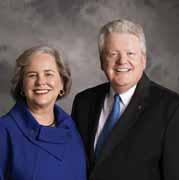







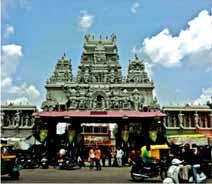


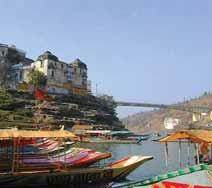

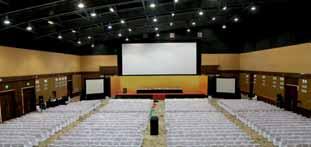

Debasish Mishra Chartered Accountant, RC Bhubaneswar Royal, RID 3262
With heavy rains lashing Odisha this monsoon, doing safe drinking water projects is a major priority for Debasish Mishra this year. Project Jaldhara focuses on equipping schools with RO plants. “All the 95 clubs will adopt a school each. A water ATM costs `40,000; half the price will be borne by the club and the rest will be funded from the DDF,” he says. A similar facility will be provided at government hospitals in the district. Here the club’s contribution for the facility will be directed to TRF and the project will be funded through CSR sponsorships. “It is a win-win as it serves two purposes,” he smiles.
Mishra is a Rotarian since 2004. He recalls how he was drawn into service during his presidential year in 2010. “RIPN Shekhar Mehta addressed our presidents’ orientation programme at Raipur. He asked if anyone will be interested in setting up an eye hospital. I volunteered and then things changed.” He went on to set up an eye clinic with a matching grant in one of the hospitals in Bhubaneswar and soon another followed. This time it was a full-fledged Rotary Eye Hospital with international partner, RC Singapore. “It serves several underprivileged people in the region.” But what touched him the most was when a Rotarian from New Zealand visited the hospital. “He had recorded the exchange where an elderly beneficiary placed her hand over my head and blessed me, thanking me for a cataract surgery which enabled her to see her grandchildren. When we met at the Seoul Convention he told me that he had shown the video in many clubs in his country and inspired by what they saw, Rotarians donated several thousands which he contributed to various other needy clubs. That really shook me,” says Mishra.
He is hopeful that the district’s project — Vision 30,000 — will treat cataract for as many needy people. Providing classroom furniture to 200 schools through corporate funding and large-scale medical camps across the district are also on his agenda.
Mishra hopes to increase membership by 10 per cent. He is aiming at 95 per cent retention of members through various programmes, one being mentoring of new members by existing Rotarians.
His goal for TRF is to raise $350,000. He is hopeful of getting major support from corporates for TRF.
A K Natesan
Educational administrator, RC Komarapalayam,
He will soon be an AKS member, probably the first from his district. Natesan was thrilled to be adorned with the AKS pin by TRF Trustee Chair Gary Huang recently. A Rotarian since 2000, his connection with the NSS, having won the State’s Best Project Officer Award twice, and inspired by PDG Chehab Elawar of RID 5330, also an AKS member, it was only natural for the DG to contribute generously to TRF. “Elawar, a member of RC San Bernardino Sunset, stayed with us for a global grant project five years ago and extolled the Foundation for the amazing transformation it does to people the world over. We must help the Foundation heal the world, he would say, and that struck a chord in me,” says Natesan. His contribution will help health and sanitation and basic education programmes.
Natesan is keen on promoting an integrated school development programme whereby clubs will collectively
improve the standards of at least 30 schools in the district. A mammography van and dialysis facilities are also on his agenda. One hundred Happy Schools, 100 Rotaract clubs, 100 Interact clubs and planting and nurturing 50 lakh saplings are his ideas for commemorating Rotary India’s centennial year.

He is confident of achieving TRF contribution goal of $700,000, and 10 per cent membership growth. Six per cent new members have already been inducted on the installation day in various clubs, although a negligible number has only registered in My Rotary. He aims at 100 per cent retention by devising interesting plans to engage Rotarians. The DG aims to raise Polio funds by distributing 60,000 contribution forms in schools and colleges, each pegged at `200.
His dream is to elevate the district and inculcate giving among his team.
Ienjoy Rotary. I have participated in every distrct activity and loved it these 22 years,” says Sameer Hariani who became a Rotarian at 24. The best memories of Rotary were leading a team of four multitalented youngsters on a GSE to Germany in 2012. “For five weeks we learnt and basked in the internationality of Rotary, soaking in the varied cultural and vocational experience.” Another cherished moment was when he served as Director for External Extension when the district set a world record in membership growth, installing 52 new clubs and 1,900 new members in a single year. “We were on the road 220 days, visiting 120 prospective locations for installing Rotary clubs in 2015–16,” smiles Hariani.
He is looking at 12 per cent membership growth this year, but quickly points out that the challenge is retention of members. “I feel that members in both old and new clubs are getting tired. We need to find reasons for them to stay back and enjoy Rotary. Sometimes we seem to forget our own Rotarians or we don’t consider their interest.”
So this year he has announced that the district will “give back to Rotarians. The spotlight will be on them and we plan involve their families too.”
On TRF goals, the DG acknowledges that the district which was a topper last Rotary year, thanks to D Ravishankar’s massive `100 crore contribution, will be expected to contribute at least five per cent more. “We have so far got commitments worth $1 million, and I am sure the Rotarians will rise to the occasion. Of course, our super-hero (Ravishankar) will be the role model.”

He is excited about Rotary India’s centennial ‘Koti Nati’ project that will see one crore saplings planted across the district. “It has become a national project now. A massive tree plantation drive is being planned pan-India on a single day, and includes nurturing the saplings for the next three years too.”
Hariani’s wife Roopa is member of the same club and has served as president of Inner Wheel.
R Madhav Chandran
He joined Rotary in 2001, inspired by his interior designer. “This was a god-send as I was totally alien to the city, having just moved from Mumbai,” says Madhav Chandran. His best memories of Rotary include the year 2007 when as club president he made his club 100 per cent PHF, “something unheard of till then”. He is happy that the Cancure Foundation formed by the club has gradually grown into a separate entity worth `30 crore now. “We do quite a lot of cancer screening and treatment, especially in villages.”
Chandran is keen on inculcating values in youngsters through a special programme called ‘Mission 2020 Responsible India’. The clubs have so far signed up with nearly 100 schools across the district and alongside sponsoring facilities there, the Rotarians groom students into better citizens with two-minute videos or short stories sensitising them on moral values and safeguarding traditions. A website is dedicated for this project which hopes
to cover 800 schools by the yearend. Setting up human milk banks is his other focus.

With 5,700 members and 45 clubs last year, the DG pepped up his team saying that they were just 600 short of being the largest district in the world. “The presidents have taken it so well and 280 new members have been inducted so far. But I have to seriously look into retention.” His thrust is on compulsory partner-participation and induction of women members. “My wife Sujata is president-nominee of my club and inspires women’s participation to a great extent.”
On TRF contribution, Chandran is keen on raising more than last year’s figure of $1.03 million and plans to achieve this by encouraging every Rotarian to contribute whatever he can to the Foundation. His mantra for Rotarians is “Don’t join Rotary to do service. Join Rotary to enjoy. Service will follow naturally.”
Dr Debashish Das
Please give me a minute. I’ll complete the prescription for this little child so that he can go back home,” says Dr Debashish Das, as I call him for an interview. His vocation drew him to Rotary even before he became a Rotarian. “I would volunteer for health camps and NIDs and inspired by the then DG Manas Chaudhuri, I joined Rotary in 2003.”
Das likes Rotary’s Heart-to-Heart and Gift of Life projects and is happy that his hospital, The Children’s Hospital, screens children for congenital heart diseases and those afflicted are sent to Durgapur or Delhi for corrective treatment. “It is wonderful to see them come back with so much happiness and a new lease of life.” His recent contribution to the Foundation will be used to treat 10 children from Haiti who will soon undergo heart surgeries in India.
His membership goal is to add 10 per cent to the existing 3,000 members which he says is achievable as in the
last three months 100 new members have been inducted. “Women’s membership in our district is just 13 per cent and I am urging club presidents to induct more women.”

Das is not satisfied with the district’s contribution to TRF. “We have not fared well in the past 4–5 years. It has been hovering around $130,000 to $140,000, and I am not sure how I will reach my goal of $500,000 this year.”
He is all excited to share his project plans which include a Rotary eye hospital, blood bank and an orthopaedic rehabilitation centre, all at Guwahati, to celebrate 100 years of Rotary in India. “I have already pitched in with $30,000 as Directed Gift,” he says. Equipping 200 schools with WinS features is also on his agenda.
Designed by N Krishnamurthy
Jaishree
Who can forget the infamous floods of August 2018 that washed away lives and livelihoods of people of Kerala and Karnataka? Kuttanad and Alleppey were among the places in Kerala that experienced the deluge on a massive scale and Rotarians across the country rose to the occasion and reached out to the flood victims in both the States with money and material. Even before life could return to normalcy, heavy rains lashed Kerala this August too. “Even now, it is a nightmare for many people here to see dark clouds gather,” said Vijayalakshmi Nair, a member of RC Alleppey, RID 3211.

The club under her leadership as Project Coordinator is reaching out in phases to rehabilitate flood victims of Kayalpuram, a residential locality with 1,500 families, in the heart of Kuttanad. “The place is close to our hearts because we witnessed the worst scenario here during the downpour,” she said. The Rotarians waded through the rainwater or sailed on boats to move people to safety, or reach food and water for the stranded victims.
“We have now adopted the locality and have helped to repair eight badly damaged houses in
the first phase.” One new house was constructed and handed over to a needy physicallychallenged person. Rainwater harvest facility and RO plants were set up. Plywood sheets were given to households to mend cots damaged in the floods.
In the next phase, a series of mega medical camps were organised to treat residents for waterborne diseases and general ailments. Mattresses, blankets, household articles, groceries and stationery items for schoolchildren were distributed.
The third phase saw moralebuilding sessions for the residents. “The psychosocial
aftermath due to loss of loved ones, property, and displacement from homes was alarming. Sleeplessness and nightmares were common complaints from people here and we arranged workshops to boost confidence especially in children and young adults,” said P O Thomas, another club member.
More recently, the Rotarians distributed jackfruit saplings for each household to enliven the environment with native trees. Since plantain and paddy cultivation were widely practised in the area, these saplings, along with manure were distributed to the farming residents.
Kamalmani Educational Excellence
Awards (KEEA) are being given to meritorious students who had received PEEF scholarships from RC Patan, RID 3292. The Prajapati Education Endowment Fund (PEEF) is the club’s flagship programme that offers scholarships to needy children in public schools.
Set up in 2013 with the initial sponsorship from late Rtn Kamalmani Dixit, the KEEA fund has since expanded with support from Rotarians and additional contributions from the Dixit family. The KEEA honours meritorious students in grade nine from among the PEEF scholarship holders with certificates and cash awards to 10 students totalling NR 100,000.
At the KEEA awards ceremony, the first prize winner, Bir Dhorj Tamang spoke on behalf of all awardees from the PEEF-supported schools and thanked the special guests from the

Dixit family and members of RC Patan for the recognition and cash awards. Eight years ago, his family moved to Kathmandu for a better life. Tamang credited his teachers and mentors at the Shree Mahendra Adarsha Higher Secondary School in Imadole, his elder brother and mother
for his academic success. “I always try my best despite failures along the way. I aspire to study engineering and want to give back to society,” said Tamang. His mother did not have the opportunity to study but always encouraged her children to study and do their best.

Rotary
Club of Belur, RID 3291, along with 34 other clubs organised a mega health camp at the Park Street Metro Station as part of Rotary India’s centennial year celebrations. About 600 people were examined for various health issues by a panel of doctors.
All the Rotary clubs in Kolkata have lined up a series of programmes to mark Rotary’s 100th year in India till June 2020 and these include medical camps, mega events and signature projects.
DG Ajay Agarwal undergoes a health-check at one of the camps.
Talkin Zamindar
Alost passport during vacation abroad is a real nightmare. Not only will it disrupt your travel plans significantly, it can lead you into a spiral of panic.
During a four-day trip to Kuala Lumpur in July along with 60 IT professionals, I had to face the consequences of losing my family’s four passports — my two children, wife and myself. We lost our bag containing the passports due to our tour guide’s negligence and this we found out only after reaching the airport for the return flight.
We filed an FIR for lost passports and the baggage at the KL Airport Police Station and returned to our hotel. We were in desperate need of guidance on how, where and whom to meet to get back our passports and belongings as all government offices were closed
the following weekend. That’s when Rotary came to our rescue. Through Facebook we contacted Rtr Zareef and asked him the contact details of the local Rotary club’s president. Zareef promptly helped us.
Soon, Rotary Club of Kuala Lumpur DiRaja President Zed Zariman (RID 3300) gave a call and came to meet us at our hotel along with Rtn Syed Rezda Shah. They assured us of all help and that they would be taking care of the necessary work to retrieve our passports with the baggage.
Zariman circulated our details on their Rotary group and all their members readily came forward to help us. Rtn Dato Ram Nair put forward our situation to the King of Malaysia and soon his secretary called me up to get details of my case.


Our official exit procedures were okayed in no time, thanks to a proper guidance from the Indian High Commissioner Anuragh Singh.
On Monday morning, within two hours we received our Emergency Certificates (white passport) and completed our exit pass procedure. We were back in India on Monday night. This is the ‘Power of Rotary’. This incident only proves that Rotary is one big global family of strangers.
Zariman helped us in every way so that we could reach home as soon as possible. His friendliness and spontaneity in handling the situation will always be remembered.
Rezda Shah was with us for two days and helped us in getting our passport photos done, the online application form procedure, and in filing another FIR. He had been with us at the airport till late night on Sunday as he searched at the lost and found department and following it up with immigration officers.
FIR.

the til as searche a o We are even took o Highland and fo dren and to m row i n g b a g to R help tions is ind w worldwide
We are grateful to Rezda as he even took our children to Genting Highlands so that they could enjoy and forget the stress. My children enjoyed his company and we are looking forward to meeting him again.
Though we had a harrowing experience of losing our passports and the baggage, we are grateful to Rotarians for their timely help. This had built new relationships in KL for us. Rotary is indeed an extended family worldwide.
(The a
The author is a member of RC Bharuch, RID 3060)



In the aftermath of a rain, you might catch a mesmerising rainbow!
But make no pre-bookings — hotels, ferry rides or watersports. Because at Andamans, everything depends on the rains. There could be last-minute cancellations,” my husband and I were warned by a friend while we were planning our honeymoon to the charming archipelago comprising 572 islands located amidst the Bay of Bengal and the Andaman Sea. So, with nothing booked and only our air tickets in hand, we landed at the Port Blair airport. After visiting five islands, we

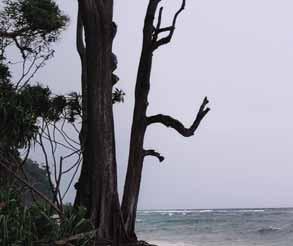


discovered that there’s a lot you can do even as the monsoon weaves its magic, leaving the land grey and wet.
Day one, we checked into a modest hotel and took the 9 am ferry the next morning to Havelock. The ride isn’t a pleasant affair. Many tourists get seasick on this ride. Don’t boast about riding on the luxury cruise that costs thrice the price of a government ferry! On this boat, you will have to put up with the ordeal of listening to miserable songs being played on its TV screen.


Disembarking at the crowded jetty at Havelock, we befriended a local autorickshaw driver who helped us check into a nearby hotel — the cozy Green Valley Resort, with cottages set between coconut palms, beside a stony beach, and with hammocks hanging under the tropical trees. The cottage cost `1,700 a night, which in balmy weather would have cost ` 4,500 a night. We soon learned to savour the blessings of the monsoon — the crowd had thinned, the scents and colours of the flowers and palm trees looked and felt more vivid; the rain only makes Andamans more charming and a lot cheaper — almost by 50 per cent.


Restaurants are lined up closely, giving you an opportunity to explore different outlets for your meals. We had to dine at our resort just once, thanks to a downpour that lasted the entire night and a good part of the next morning as well. By noon, we were happy to get out, clad in raincoats, on a hired scooter (`350 a day) to explore the island. We reached the spectacular Radhanagar beach on the east side of the island. The ride through the towering trees was spectacular.
To warm yourself up after a cold and wet day on the beach, you could head straight to Something Different, a beachside resto-bar. Sip on some pina colada in a pineapple cup and do try the steamed fish with scallions and ginger. It’s a splurge but totally worth it. If you decided to step out and watch the serene beach and corals from the restaurant walkway, you will be surreptitiously charged ` 100 extra for ‘reef watching’!
For our first scuba dive, we visited the sport centres close by to get a good idea of what was on during such a lean season. We visited three centres and settled for `2,000 a person (otherwise costs `4500), all-inclusive of a scuba training, 10-metre dive for half an hour and pictures and videos of us underwater. After a safety briefing, we were at a depth of about 8.5 meters in the sea! Seeing small red scorpionfish, yellowtail snappers, colourful parrotfishes, cute little yellow box fish feeding on

algae and reddish-orange coloured worms in the shape of cypress trees makes this a must-do in the Andamans.
To head to Neil Islands, use the government ferry. For the locals, a ticket costs cost `62, but tourists have to pay `550. You can opt to sit on the deck for the entire ride and if you are seasick, a crew member will fetch you a lemon

and some salt to calm your senses. Located 37 km south of Port Blair, Neil is known as the vegetable bowl of the Andaman Islands. There are no fancy restaurants in Neil Island — shacks by the beaches with plastic tables and chairs serve freshly made food in the open-air setting. A decent fish thali starts at only `140 and the mustard okra is outstanding! Remember you get the most delicious rasgullas in the Andamans only in Neil and make sure to buy them.
Unfortunately thanks to the grey monsoon sky at Neil, we did not get to watch the sun dipping down at the gorgeous Lakshmanpur beach. Neither did we catch it rise at the Sitapur beach. But everything is beautiful and laidback in the rains… unexplored coral reefs, the deserted white sand beaches, and tropical woodlands! So calm that you may catch dogs and

squirrels performing yoga! Although the local guides will harass you to hire them, take a walk alone to the Natural Coral Bridge at Beach No 2 in Neil. The bridge is a beauty and the shallow stony beach around it boasts of amazing marine life. You will get to see hundreds of starfish and sea cucumbers alongside green shore crabs.
A 15 minute-boat ride from Port Blair will bring you to Ross Island, where you can spend three hours walking through the eerie ruins of the old British settlement almost completely swallowed by strangler fig trees, peepal trees and green moss. The rains add to the gloom and if you want to see the creepiest ruins, head to the cemetery that dates back to 1857 on the western side of the island. A small
detour off the main path will cut you from the crowds, and a bridge across the sea will lead you to a charming old lighthouse beside the statue of the Lone Sailor.
It was the Ross Island that took the massive brunt of the 2004 tsunami and saved the city of Port Blair from major destruction. Unless you want to do an expensive scuba dive or snorkeling, going to the North Bay Island will be an utter waste of time and since Mount Harriet, during the monsoons, is infested with leeches, we decided to give it a miss.
The most exciting part of the trip was the drive to the Baratang Islands, 150 km from Port Blair. After reaching Jirkatang Post, a convoy guides you through a 49-km-stretch to the Jarwah
Reserve Forest, where you can’t stop your vehicle to take pictures or get out of it. On the other end of the Jarwah Reserve Forest is the Middle Strait jetty. A ferry takes you to the other side of the strait in about 15 minutes and small boats transport you to the mangroves of Baratang, from where a tough 1.8-km-trek leads you to the

Block No.6 at the Cellular Jail, Andamans.
Below: A decent seafood meal.

natural limestone caves. The natural formations are breathtaking and your guide-cum-boat driver will show you formations ranging from mythical characters to giant crocodiles and human faces. We spotted two Jarwah men walking in the rain under a huge green leaf on our way back through the reserve forest.


It was the Ross Island that took the massive brunt of the 2004 tsunami and saved the city of Port Blair from major destruction.
The city tour includes a visit to the Cellular Jail that stands as a dark reminiscence of British rule in the Indian subcontinent. Solitary confinement of freedom fighters in individual cells earned the jail its name, ‘Cellular’. You might be scared out of your wits to find movement inside a locked dingy cell, but hey! it’s just an over-enthusiastic tourist trying to go back in time to see what it was like to remain in solitary confinement. After visiting a few museums, you can head to Corbyn’s Cove beach to spend the rest of the evening. This is one of the most sought-after beaches in Port Blair, having several Japanese World War-II bunkers.
Wandoor and Chidiya Tapu are must-visit beaches, 30 and 35-km from Port Blair respectively. On the way to Wandoor, our auto driver told us stories of survival from the 2004 tsunami, as we passed by fields and homes still flooded with seawater from the tsunami that ravaged this region 15 years ago. “The sticky soil wouldn’t let it drain away from the
land and from our memories. Close to 10,000 lives were lost then,” he said grimly.
We wandered through the markets of Port Blair, almost every evening of our stay. The market is dominated by women vendors and brimming with the fresh catch of the day. The vegetables and fruits look fresh and sparkling in the rain. After a heavy rainfall it feels marshy, sticky and crowded — a sea of bargaining humans, dead fish and hungry mongrels. By the end of the trip we knew exactly where the ATMs were, had named the mongrels loitering around our homestay, got acquainted with the woman selling fish by the jetty, the timing of the Somu’s pani puri stall, and the location of Bhuvaneshwari akka’s lemon soda shop.
It became a routine to drink tender coconut water, eat bananas and tuck in fried fish at every other restaurant. This unfamiliar land suddenly began to feel like home, making you wish you could stay a little longer.
Pictures by Kiran Zehra
When the mind is empty, the heart is deeply moved by all mystical and poignantly beautiful things in the world. Recently, I saw a video of a brown little bird called the canary da mata. Perched on a log of wood, this little bird spread out its wings like a semi-circular fan and raised them to the heavens even as it looked up at the skies. It did this once. It did this twice. And a third time… Apparently, it does this every morning at sunrise. Words fail me as its beauty fills me…
Life is mysteriously, magically beautiful. Allow its beauty to enter you every day, for, to experience beauty is to experience your inner health fully in a wholesome and pleasing way. Indeed, pure beauty is a physical healing force. We catch our breath in its marvellous vibrations, stirred to our very depths.
An experiment in truth. We’ve often heard how stress works on us. Beauty works on exactly the same route but with opposite effects. As we already know, we always carry in us germs and bacteria of all kinds. Now we are learning a little more about our workings vis-a-vis these little ever-floating organisms. A scientist put cells in two petri dishes. In one dish, he placed nutrients, in the other, toxins. Half an hour later, he observed that the cells had moved towards the nutrients… And in the second dish, the cells had moved away from the toxins and closed themselves! Just imagine what happens inside you when you drink in a beautiful sunrise or the uplifting
actions of the canary da mata! Your cells literally open themselves out and bask in the sweet nourishment provided by you. Your mind sends signals to the hypothalamus saying, “It’s a supportive environment!” which in turn, directs these positive signals to the pituitary gland which then transmits them to all the cells in the body.
When you go through a breathtaking experience, it’s a pranayama-plusexercise. The word aesthetics is, in fact, derived from the term ‘I breathe deeply’ or the more colloquial ‘I gasp’. Pure innocent pleasure and delight do that to us. We breathe like we’ve never breathed before — in wholeness of body and spirit, in integration
of order and emotional energy, in an inner environment suffused with harmony. The Wise say, “God is breath passing through you.”
I promise you, I felt this intensely when I read the true-life anecdote about Lawrence Anthony, a legend who lived in South Africa, who wrote The Elephant Whisperer and exhibited immense courage and resourcefulness in rescuing wildlife from human cruelties. It is known that he rehabilitated many elephants from all over the world. His rescue of zoo animals in Baghdad during the US invasion in 2003 is epic.
On March 7, 2012, Anthony died, leaving behind his wife, sons and

grandsons. Two days later, 31 elephants from different parts of the wild reached his home to bid him farewell. It is said they walked over 12 hours to get to his South African home. They stayed outside his home for two nights without eating, only mourning, showing deep respect, affection and gratitude. And on the third morning, they left as silently and reverentially as they had come.
A window of beauty. Each and every one of us needs such a ‘window of beauty’ to look through and allow the hard crust of cynicism, bitterness, guilt, hatred, illness to be gently and persistently dissolved to give way to a soothing, luminous inner hush. Then life does not become a struggle for survival or merely a corporate climb up the ladder or a race against disease and time, but a silent, still, mystical realm where you step out of time for an instant to touch eternity. And you
are exactly where you are, seeing with your heart. It is about taking the day off to do nothing or do something that you don’t do the rest of the week. Take a long, slow walk letting your feet touch the welcoming earth, your eyes touch the cooling greenery, your skin touch the bracing breeze. Or get into a hobby or personal ritual to bring out your blessings and the things and feelings that are tender and beautiful in you. Catch a musical drama or film, attend a talk, stand-up comedy or poetryreading session, paint a butterfly or lie on the sand and listen to the sea…
Light little lamps. In a neighbourhood with a high crime rate in Kingston, Jamaica, streets were cleaned of graffiti and garbage, broken lights fixed, flowering plants sown… It brought hope and security. Skill-development courses, family support programmes were initiated on the hopeful heels of the clean-up drive. And the crime

rate dropped dramatically. If you find life difficult, think of ways you can infuse beauty into it. Light your own little lamps. A cartoon titled Frank and Earnest by Bob Thaves shows a guy drawing the curtains apart and telling the other guy, “I don’t think I’m letting sunlight in when I open the curtains. I think the darkness is going out.” The sun is never sure if it will be obscured by clouds the next morning, yet it continues to shine. Next day, even the next moment, is a mystery. Just keep shining and give your best. Feel the thrill of living. Be like the lotus and thrive in all conditions — research is on to duplicate the lotus leaf surface-effect and manufacture repellent coatings. Deflect negativism with grace — like the lotus leaf.
A voyage so beautiful… When you take life as a mystical voyage on a spaceship called Earth around a massive fireball called the Sun, wearing your space suit — the body — you begin to understand the importance of travelling light in mind, body and spirit and living in wonder, in “a land of contrast and incredible intensity where the sky is the size of forever and the flowers the size of a millisecond.” These incredibly beautiful words are written about the alpine tundra by Ann Zwinger and Beatrice Willard in their book The land above the trees
Even a molecule of our DNA, according to science, has an intrinsic elegance, clarity and harmony in its structure. It is what makes us mysterious and luminous when we awaken the light within. It is important for all of us to focus on the beauty of life’s moments and allow all our anger and frustrations and stress turn to peace.
The writers are authors of Fitness for Life and Simply Spiritual – You Are Naturally Divine and teachers of the Fitness for Life programme.
Unfortunately, some people get so depressed as a result of their mental illness or stress, that they consider suicide as an option to escape their emotional pain. They don’t really want to die; they just don’t know how to cope with or eliminate the pain they are going through. These thoughts were shared by Rtr Dhruv Parikh, President of Rotaract Club of ISME, RID 3141.
The Rotaractors commemorated World Suicide Prevention Day (Sep 10) with anti-suicide campaigns. ‘Working together to prevent suicide’ is their club’s theme for the year. The Rotaractors visited schools, colleges and


A session on self-development in progress.
offices and conducted events such as slogan writing contests where the participants had to write positive messages to overcome suicidal inclinations, and essay competitions where they had to write words of encouragement to people with suicidal thoughts. The charts and essays were displayed on the campuses for a wider awareness and reading.
Place your hand over your heart, can you feel it? That is called purpose. You’re alive for a reason, so don’t ever give up. When you feel like giving up, just remember the reason why you held on for so long. If you kill yourself, you are also going to kill the people who love you. Pleasure and pain are two aspects of life. They are inseparable. If you are experiencing the painful side of life right now, you
will inevitably experience the pleasurable side in the future — the tide will turn.
The Rotaractors shared these positive messages in the talks they delivered at the various campuses.
“By the end of the programme, we were very satisfied that we were able to address a traumatic yet less-recognised issue plaguing all parts of the world,” said Parikh.
The club, along with RAC S K Somaiya and RC Bombay Powai, organised a session on selfdevelopment at the ISME campus. Motivational speeches were delivered by Sharmee Divan, Pavan Badlani and Raj Shamani on loving yourself, taking risks, facing failure and the art of giving. “It was the kind of session that helped students relate to personal challenges and inspired them to think big,” he said.
For the third consecutive year, RC Dalmiapuram, RID 3000, has organised ‘Seed Balls Festival’ in association with Dalmia Cement. The aim was to usher in a green environment in the town in Triuchy district of Tamil Nadu and its surrounding villages.
Students from Dalmia Higher Secondary School, Dalmia Vidya Mandir and Sri Ramakrishna Dalmia Industrial Training Institute came together to make around 20,000 seed balls. Around 16 varieties of seeds including neem, pungan, banyan and bamboo were used for making seed balls.
DG Zameer Pasha was accompanied by Bhuvan Unhelkar from RC Sarasota Sunrise, RID 6960, Florida, USA. Besides Rotarians and district leaders, members

from Dalmia Ladies Club and employees of Dalmia Cement and Dalmia Refractories were present to encourage the students. “The seed ball festival is one way of
expressing our social responsibility to the environment and also helped to promote Rotary to the younger generation,” said A Maria Selva Rex, Secretary, RC Dalmiapuram.

Rotary Calub of Pune Yuva, RID 3131, has been conducting a series of guidance-cumcounselling sessions called ‘Success Mantra’ for Class 10 students across Pune. The yearlong programme aims to motivate children appearing for the Board exams and alleviating the related fears.
Educational experts give valuable tips on studying techniques and presenting the answers. Parents and teachers also attend these workshops.
So far, the programme has touched around 5,000 students from various schools in the district, says Club President Rahul Gadkari.

A Rotary stamp was released by District Governors Dr A K Natesan (2982) and Dr Zameer Pasha (3000) to mark the 100th year of Rotary in India. The same was presented to RID Kamal Sanghvi and PRID C Basker. The project was sponsored by Public Image Chair K Karuppiah.

One hundred saplings were planted around the campus of IAB Higher Secondary School run by the Indian Association for the Blind. Drip irrigation system was also installed to water the saplings regularly.

As part of its anti-plastic drive, over 1,000 cloth bags were distributed to the public along with pamphlets. A club president from Malaysia and his spouse took part in the campaign.
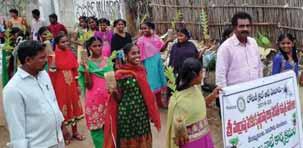
Under their ‘Grow more trees’ campaign, the club distributed 200 plants at various locations in Veerammakunta village in the West Godavari district. Students of the Zilla Parishad High School were encouraged to plant saplings on the school campus.

For the 11th consecutive year, the Interact Club of St John’s School has taken up paper collection drive where Interactors collect unused papers of notebooks from students at the end of the academic year and bound them into fresh notebooks for distribution to students.

The club sponsors monthly groceries for 25 visuallyimpaired families under its flagship Sudama Ni Joli project. The monthly cost of `8,000 is either borne by members or donated by benevolent public for the noble cause.

Twenty-five teachers from various schools in the city were felicitated on Teacher’s Day. Club President Col Manoj Gupta and other Rotarians were present at the event.
Nation Builder Awards were presented to 32 teachers at a seminar on Teacher’s Day at the Dr Gagandeep Rotary Public School in the city. Special talks were given by Club President Yash Paul Mangala and Navin Garg to highlight the skills of teachers in nation building activities. Cultural programmes were staged by students.

Rotarians celebrated Independence Day with students at Lead Convent School. A cultural show was staged. School bags and certificates were given to the winners.
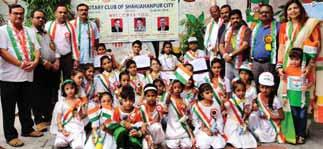

An artificial limb fitment camp was held at the Rotary Help Centre in which a large number of amputees were benefitted.

Six students from Dyan Mandir School were given free computer training for three months through a project sponsored by past president Rameshji Khandelwal.

Musical instruments worth `85,000 were given to 20 visually-impaired artistes. The project is aimed at building their self-esteem by involving them in creative activities.


School bags were distributed to students from floodaffected families at the BES Group of Institutions. A large number of Rotarians were present on the occasion.

Five handwash stations were donated to primary and middle schools with handwash instruction boards erected in front of the hygiene facilities. This WinS project implemented at a cost of `75,000 will benefit 300 students.

District Project REACH — Rotary Empowered Action for Cleanliness and Hygiene — was inaugurated by Thiruvananthapuram Mayor V K Prasanth at the Holy Trinity High School. Club President Shyam Starry Pereira was present along with other Rotarians.

Teacher’s Day was celebrated by felicitating two teachers and garlanding the statue of former President Sarvepalli Radhakrishnan who was born in Tiruttani. Club President Hari Kumar Sharma and other Rotarians made the awards ceremony a success.


A vocational centre run by the club trains students in air-conditioning and refrigeration services. This year, one more batch of 20 students is being admitted for the one-year programmes. Food and accommodation are also provided free for needy students.
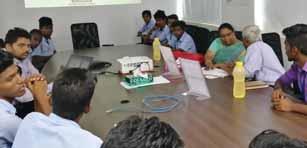
The club provided various prosthetics, aides and crutches including smart tools to 190 physically-challenged people of Bongaigaon and Chirang. The project done with other NGOs cost `23 lakh to the club.

Raincoats were distributed to needy students at its adopted school in Pandra locality so as to ensure 100 per cent attendance during rainy season. IPDG Bhawani Choudhury presented the raincoats to children.
You can pay the Rotary News / Rotary Samachar subscription online
Our Bank details:
Bank : HDFC Bank SB Account
Branch : Montieth Road Egmore, Chennai
A/c Name : Rotary News Trust
A/c No. : 50100213133460
IFSC Code : HDFC0003820
E mail us following details: Name of Club
President/Secretary’s name
Amount/Date of transfer/UTR Number
For physical payment by cheque or cash in bank, write Club Name only without prefixing “Rotary club of”. Eg. Rotary Club of Delhi Central should be written: Delhi Central.

Gilead
Author : Marilyn Robinson
Publisher : Hachette India
Pages : 282; ` 399
Gilead is a book about a book about fathers and sons. The book is an account of the memories and legacy of John Ames as he remembers his experiences of his father and grandfather to share with his son. In the form of a letter from 76-year-old Ames, who is a fourth-generation Congregationalist minister, in Gilead, Iowa, in 1956, to his sevenyear-old son. This is an intimate tale of three generations starting from the Civil War to the 20th century: a story about the spiritual battles that still rage at America’s heart. Ames who is suffering from a heart disease, sums up his past and his learnings in his letter sprinkled with anecdotes and advice. This book has won the 2005 Pulitzer Prize for Fiction and the National Book Critics Circle Award.

Author : Adity Kay
Publisher : Hachette India
Pages : 384; `399
The kingdom of Magadha, India, is at its peak, but the young prince Chandra’s thoughts are clouded as his elder brother, Ramagupta, prepares to take their ageing father’s place on the throne. Chandra is bound to obey the future king but is in constant disagreement with him. He believes his brother’s decisions will joepardise the stability of the empire… and so begins a tale of conflict. One is drunk on power and unconditionally supported by the court of Pataliputra, the other an outsider in the palace, who is yet to win the hearts of his people. But when a strong enemy strikes the kingdom and challenges the Guptas’ might, Chandra must first fight his own battles in order to protect his people and become a king in his own right — he must become Vikramaditya.
I have a theory about that
Author : Judy Balan
Publisher : Hachette India
Pages : 244; `399
Thisis a light and refreshing read. Meg and Tania, two besties and flat mates, are on a mission to find themselves their “true love” over a bet. While Meg is a meticulous planner, Tania is a go-with-the-flow and trust-in-the-timings-of-theuniverse kind of a girl. The two live by their theories of finding their Mr Right and the plot takes some crazy turns until everything’s set in place. Tragic break-ups, emotional break-downs, work pressure and some growing up takes the reader to a happy end.


Edited by : Vinay Kumar Malhotra
Publisher : VVM Trust

Pages : 84; `250
This book presents a positive vision on aging, continued learning after 70 and replaces “retirement” with “advanced age of learning.”

Mera Ambala –
A collection of poems
Pages : 80; `250
Acollection of poems read at the Poetical Symposium on “Mera Ambala”. These poems describe the beauty and struggles of the city of Ambala.
Compiled by Kiran Zehra
Designed by Krishnapratheesh S
Travelling abroad poses two major problems for people who read a lot. One is what books to carry; the other is how many. I know Kindle and Google between them have taken care of this problem now but for older people who prefer printed books, it is still a cause for worry. I am told Somerset Maugham, who not only read a lot but travelled a lot as well, used to carry a huge sack which was full of books of dozens of types. But then, those days there was no air travel and even after it came along, weight was only a minor problem. Maugham used to travel by ships and could carry 50 kilos of books with him. And porters were cheap. Today you would be lucky to be able to take along a tenth of that. Maugham, if he didn’t like a book, had the luxury not only of discarding it but also of being able to find something else to read in his sack. Today you can still discard a boring book but then what do you read instead if you brought only five or six books? That is why you find most people carrying what, for the want of a better term, are called ‘comfort
Somerset Maugham used to travel by ships and could carry 50 kilos of books with him.
books. This is like comfort food — curd rice or dal chaval — and comfort music — film songs of the 1950s and 1960s. They are risk free books.
When I googled “comfort books” it threw up pages upon pages of entries. These, according to bloggers, are the same books people turn to again and again. But honestly, how many times can you read the same book? My formula is to the same writers. I have about 20 favourite writers in all comprising thrillers, history and chicklit. I asked some friends who still read fiction — there are very few indeed, for some reason — whether they too had a secret cache of comfort writers. Most of them said yes, albeit somewhat grudgingly, I don’t know why. There’s nothing to be ashamed of. One of them also said reading them is like going to bed in old pajamas. Nice. What a wonderful way to put it.
It’s not very clear what it is about these comfort things which is so comfortable. Familiarity, predictability and association are probably one of the factors. But the lack of surprises, especially as one grows older, must also play a part surely. Who wants to eat an idli stuffed with keema? Those used to be available in some restaurants about 30 years back, along with keema dosas. Where writers are concerned, I am not sure whether it is their style or the characters they create, or both. I find that regardless of which new character/s they are writing about, most

Reading comfort books is like going to bed in old pajamas.
writers follow the same style and that is very comforting. Once in a while, though, possibly because of urgings by someone close to them to do something different, they vary the style. It always ends in disaster, both in sales and reviews. Then they scurry back to their natural style.
But I suppose there are also writers who would like to show their talent by writing in different styles. They cause a lot of discomfort for agents, publishers, marketers and, of course, readers. The clever ones, however, write under a different name, while taking care to let it be known that the new Y is actually the old X. The most recent example of this is the creator of Harry Potter, J K Rowling. She has been writing as Robert Galbraith for a few years now. But in my view at least these new detective novels are really not up to scratch.
So, here’s a piece of advice. If you are the reading type, when you are travelling stick to authors you are familiar with. Don’t experiment, because you could find yourself without anything to read.

With hike in penalties and tighter road traffic regulations under the amended Motor Vehicles Act, R Shah, a resident of Vadodara, has stuck his driving licence, registration certificate, insurance papers and other relevant documents on his helmet, lest he forgets them. “Helmet is the first thing I put on before riding my bike. That’s why I pasted all the documents there so that I don’t face any fine,” he says. And a man in Aligarh was spotted wearing a helmet while driving a car, for he was fined for not wearing one while he was riding a four wheeler!

No more sweating it out now, for you can wear an airconditioned T-shirt.
A Sony-affiliated startup has launched a Bluetooth device called Reon Pocket, designed to be worn with a special silicon material T-shirt that has a pocket on the back, just below the neck, that holds it in place. Controlled through an app, the device can cool its wearer down by 13 deg C, or on colder days, increase the temperature by 8 deg C. It has a battery life of 90 minutes and takes two hours to get charged. The device is presently available in Japan for $120.


Alexis Brett (39) in Britain finally delivered a girl child after giving birth to 10 sons in a row. She had almost resigned herself to living in an all-male household and was delighted when she gave birth to her 11th child. Cameron is now the kid-sister for the boys aged 7 to 17 who, according to Alexis, are much better behaved around her. The couple is not planning any more children.
When news of eighty-year-old Kamalathal selling idlis for a rupee in Coimbatore went viral on social media, offers of help poured in for her. Taking note of her cooking the idlis on a firewood burner, industrialist Anand Mahindra tweeted, “If anyone knows her I’d be happy to ‘invest’ in her business & buy her an LPG fueled stove.” Soon both HPCL and BPCL came forward to offer LPG connection to the octogenarian. “Salute the spirit and commitment of Kamalathal. Glad to have helped her through local OMC officers in getting LPG connection,” tweeted Union Minister for Petroleum and Natural Gas Dharmendra Pradhan.

All of us are familiar with a childhood threat that when you bump your head against a wall you’d grow horns. And a highly egoistic person is often described as having two horns. But Shyam Lal Yadav, a farmer in Madhya Pradesh, did grow a four-inch horn on his head after he bumped his head in 2014. He was regularly getting the growth shaved by a barber until he recently got it surgically removed by neurosurgeons at the Bhagyoday Tirth Hospital in Sagar. The doctors refer to this rare growth as a ‘sebaceous horn’ or a ‘devil’s horn’.
Regn. No. TN/CCN/360/2018-2020
Licensed to post WPP No.TN/PMG(CCR)/WPP-431/2018-2020
Total number of pages in this monthly issue, including cover, 84. Price: `35
Registered with Registrar of News Papers for India 3880/57 Rotary News Published on 1st of every month








